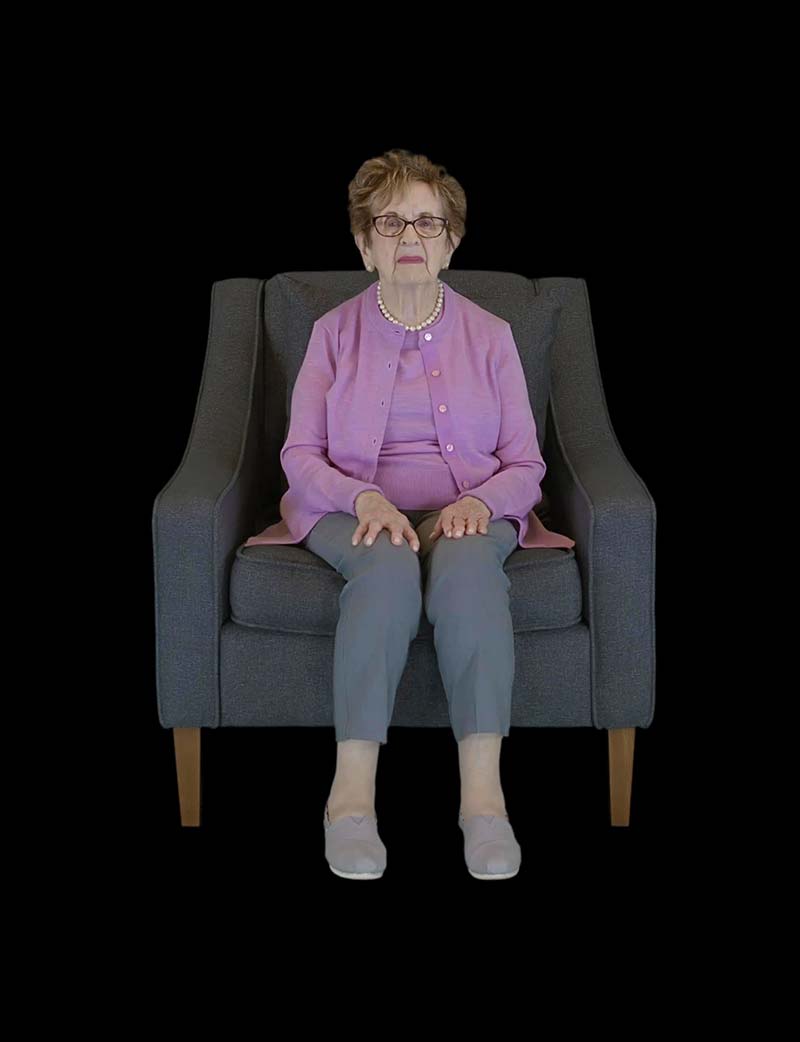Nimrod (Zigi) Ariav
Interviewed in English and Hebrew in 2017
Nimrod ‘Zigi’ Ariav was a survivor of the Holocaust who lived in Tel Aviv, Israel. Zigi was born Szulem Czygielman in Lublin, Poland, in 1926 to a Reform Jewish family consisting of his mother, father, and twin brother, Avraham. In 1939, the German army invaded and began persecuting the Jewish population. Although the Jews of the town were forced to wear armbands, Zigi decided to remove his armband (vowing to never wear it again), which allowed him to pass as a Polish gentile. The family fled to the smaller town of Belzcye in 1940 to join Zigi’s maternal family and escape some of the persecution they faced in Lublin. Although Zigi, Avraham, and their mother escaped the deportation to Majdanek, Zigi’s father was shot and killed during the transport. Zigi eventually moved to Warsaw under a false name, posing as a Polish refugee, and became actively involved with Armia Krajowa, the Polish resistance movement. His twin brother was killed in 1943 after his Jewish identity was discovered. Zigi fought as part of the Polish Home Army during the Warsaw uprising; he was injured and transported to a hospital in Krakow, where he was liberated by the Russians in March, 1945. After the war, he discovered his mother was still alive. He remained in a displaced persons camp for two years, eventually joining the Haganah in 1947. In 1948, he enlisted in Israeli Army through the Haganah and moved to Israel the same year and joined the Air Force. He married Holocaust survivor Odette Finkental and they had two sons. Zigi passed away in 2023.
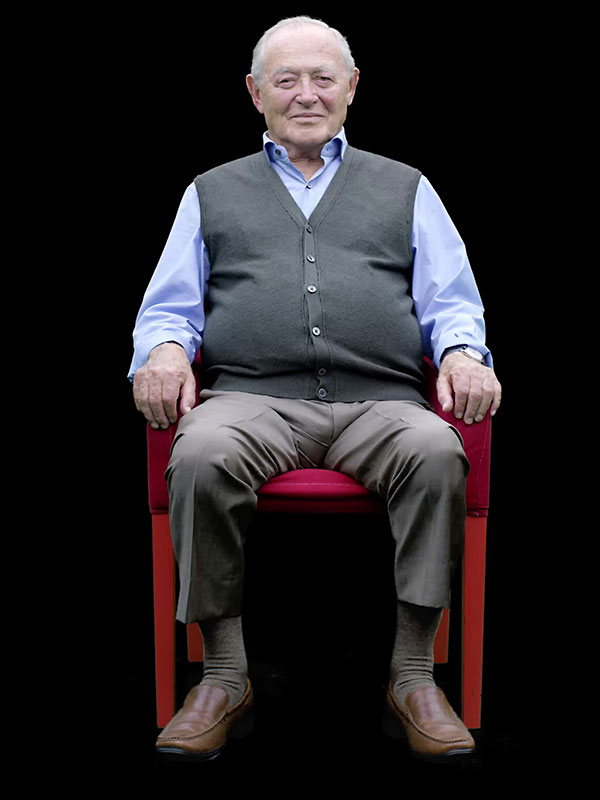
Inge Auerbacher
Interviewed in German in 2022 in New York City, New York in association with the German National Library.
Inge Auerbacher is a survivor of the Holocaust who lives in New York. Inge was born on December 31, 1934 to parents Berthold and Regina Auerbacher. The family, including Inge’s grandparents, lived in the small town of Kippenheim, nestled between the Black Forest and the French border. Inge’s father was a disabled veteran, having fought for Germany in World War I, and owned a textile business.
In 1938, right before Inge was about to turn four, violence tore through her town during Kristallnacht. Inge hid in the shed with her mother and grandmother. Inge’s father and grandfather were arrested and incarcerated in the Dachau concentration camp. They returned several weeks later, but Inge’s grandfather passed away soon after. The family was unable to leave Germany, and faced harsh restrictions. In 1941, Inge’s father was able to postpone the family’s ordered “resettlement,” but Inge’s grandmother was sent to her death in Latvia.
On August 22, 1942, Inge was deported with her parents to the Theresienstadt ghetto in Czechoslovakia. The family was able to remain together in a special section of the ghetto for disabled veterans. Conditions were still horrible and Inge was hungry, scared, and sick most of the time. After almost three years, on May 8, 1945, Soviet troops liberated Inge and her family. They immigrated to the United States in May of 1946, landing in New York City. Inge has had a long career as a chemist and has published a play as well as multiple books about World War II.

Stanley Bernath
Interviewed in English in 2017 in association with Maltz Museum of Jewish Heritage
Stanley Bernath was a survivor of the Holocaust who lived in Cleveland, Ohio. Stanley was born Zoltan ‘Zoli’ Bernath in Carai, Romania in 1926. He grew up with a father, a mother, and two brothers. His youngest brother and father passed away before the war. The war began in Romania when the Hungarians invaded and occupied the country in 1940. In 1941, his older brother was sent to a forced labor camp where he would spend the rest of the war. In 1944, the Germans invaded Romania and forced the Jews into a ghetto. Stanley and his mother moved into the ghetto and were deported to Auschwitz. Stanley was then separated from his mother and spent the war in three other camps: Mauthausen, Melk, and Ebensee. He was liberated in Ebsensee by the Americans in 1945. After liberation, he was reunited with his older brother and mother in Romania. After spending some time in the DP camp, Stanley was able to immigrate to the United States in 1945. He later joined the U.S. Army and was stationed in Germany for four years serving in Army Intelligence. After his military service, he moved to New York where he worked as a taxi driver. He married Holocaust survivor Arlene Weiner and they had twin daughters. The family moved to Cleveland, Ohio, in 1955 and Stanley worked as an electrician and contractor. Stanley passed away in 2019.

Dolly Botton
Interviewed in Spanish in 2020 in Mexico City, Mexico.
Dolly Botton is a survivor of the Holocaust who lives in Mexico City, Mexico. Dolly was born Dolly Haim in 1929 in Kavala, Greece. She was the only child of her parents Simon and Marcell Haim. The war started for Dolly and her family in fall of 1940 when Italy invaded Greece. In spring 1941, Dolly and her parents moved to Athens due to the dangers of heavy bombardments.
In 1943, the family went into hiding and stayed in different places, afraid of being rounded up and deported to labor or death camps. In March 1944, Dolly’s father registered his family as Jews after being blackmailed several times. Soon after that, he was deported to a concentration camp, where he perished. Dolly and her mother were able to stay in hiding, surviving multiple close calls with near discovery, until Athens was liberated in October 1944.
In the 1950s, Dolly went to study music in the United States and took a job with a music and arts nonprofit in New York. In 1963, she married another Holocaust survivor from Greece, Julio Botton. Dolly and Julio moved to Julio’s home in Mexico together. They had two daughters, Melina and Aliqui, and lived together in Mexico City for more than 50 years until Julio’s passing in 2021.

Julio Botton
Interviewed in Spanish in 2020 in Mexico City, Mexico.
Julio Botton was a survivor of the Holocaust who lived in Mexico City, Mexico. Julio was born in Thessaloniki, Greece, in 1928 to a family of Sephardic Jews that consisted of his parents, Haim and Sara Boton, and a younger sister, Flora. His father ran a fabric retail store while his mother managed the home.
The war started for Julio in the fall of 1940 when Italy invaded Greece and bombed Thessaloniki. It progressed with the German invasion in April of 1941; Julio remembers hunger across the town and the prevalence of the black market. The Germans introduced the Nuremberg Laws to Greece and deported Jews to ghettos and camps. The Bottons avoided the initial deportations due to their Spanish citizenship. The family fled to Athens in 1943, but were deported to the Bergen-Belsen concentration camp in 1944 when they turned themselves in with the hope of being sent to Spain. The US Army liberated Julio and his family in April, 1945, in the middle of their transfer to Theresienstadt.
After the war, Julio went to study textiles in France and soon followed his parents’ immigration to Mexico. He married Dolly Haim, another Holocaust survivor from Greece, after meeting her while visiting friends in the United States. Julio and Dolly had two daughters, Melina and Aliqui, and lived together in Mexico City for more than 50 years until Julio's passing in 2021.
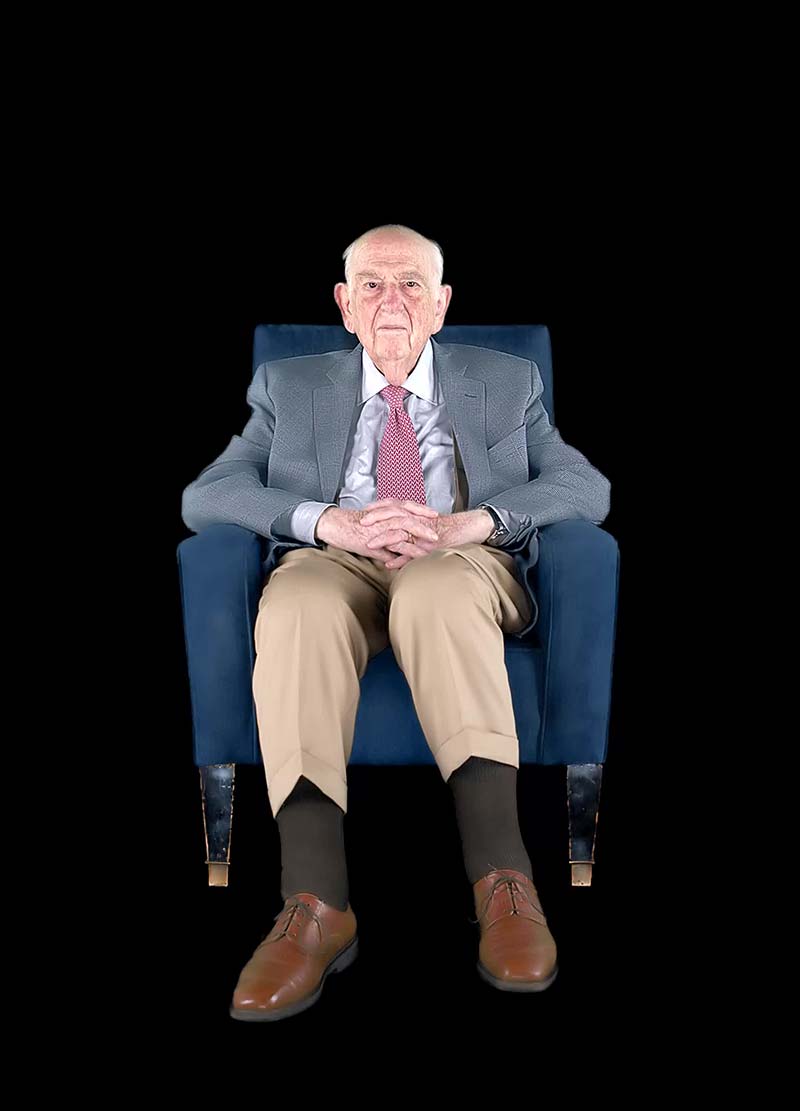
Elisabeth Citrom
Interviewed in Swedish in 2020 in association with the Swedish History Museum in Stockholm, Sweden.
Elisabeth Citrom is a survivor of the Holocaust who lives in Växjö, Sweden. Elisabeth was born Elisabeth Schreiber on October 8, 1931, in Targu Mures, Romania. Her parents, Leopold and Malvina Schreiber, raised Elisabeth and her brother Isidor in a traditional Jewish home. Elisabeth and her family spent their summers at grandmother Bluma’s countryside home in Transylvania.
From 1940 on, Elisabeth recalls antisemitic bullying from peers and teachers. When the Romanian state seized the family’s home, the Schreibers were forced to move in with Elisabeth’s grandmother. In the spring of 1944, the Hungarian Police Forces seized her grandmother's home as well. The Schreiber family was forced into a ghetto nearby before deportation to Auschwitz-Birkenau. It was the last time Elizabeth saw her mother and grandmother. Over the span of a year, Elisabeth survived several different concentration and death camps. Near the end of the war, she was forced on a weeks-long death march. The Americans liberated the marchers at an Austrian slave labor camp, but they were in a grim state. Elisabeth had severe tuberculosis.
After an unexpected recovery, Elisabeth moved to Israel. She served in the IDF, helped build a kibbutz, joined a youth movement, and pursued an education as an operating room nurse. After meeting her future husband, fellow Romanian Holocaust survivor George Citrom, the couple immigrated to Sweden to live by Elisabeth’s father and brother. Elisabeth has had a long career in nursing, many leadership roles in her community, as well as two children and six grandchildren.

Morris Dan
Interviewed in English in 2022 in association with the Holocaust Documentation and Education Center in Dana Beach, Florida.
Morris Dan was a survivor of the Holocaust who lived in Margate, Florida. Morris was born in October 1925 in Ciechanów, Poland. Morris’s father, Chanoch, owned a bakery. His mother, Sarah, was a homemaker who cleaned houses to help make ends meet. Still, Morris and his eight siblings grew up very poor. Morris remembers attending shul with his grandfather, and feeling a connection with religion that none of his siblings shared.
Nazis occupied Ciechanów in September 1939, and immediately started persecuting Jews. Anti-Jewish measures were enforced, such as wearing a star of David on clothing. Of Morris’ six brothers, three fled to the Soviet Union. In 1941, Morris and his remaining family were forced into the Nowe Miasto ghetto in a nearby town. In 1942, they were deported to Auschwitz where Morris’ parents, sisters, and youngest brother were killed on arrival. Morris stayed imprisoned in Auschwitz until January 1945, after which he was sent to several other camps in Germany. In April 1945, Morris was set for a transfer from Buchenwald to Theresienstadt. He was liberated on May 8,1945, near the end of the route.
After the war, Morris lived in Germany before immigrating to Canada in 1949. In 1953, he married his wife Sophie, who is also a survivor of the Holocaust. They decided to move to the US in 1969. First, they lived in New Jersey and then in Florida. Morris and Sophie raised three children together. Morris passed away in 2023.

Paul Drexler
Interviewed in English in 2021 in association with the Sydney Jewish Museum in Sydney, Australia.
Paul Drexler is a survivor of the Holocaust who lives in Sydney, Australia. He was born Pavel Drexler on June 29, 1938 in Spacince, Czechoslovakia. His mother, Helen, nicknamed him ‘Palko.’ She and Paul’s father, Eugene, maintained a traditional Jewish home where the family kept Kosher and practiced Shabbat. Paul remains an only child after his younger sister died as an infant.
In 1942, Hitler demanded Slovakia deport its Jews to Poland. Paul’s family received rare exemption certificates for his father’s work as a wheat farmer. Even while exempt from deportation, Paul remembers hiding from patrolling Nazis with his father. Two years later, the Nazis canceled the exemption certificates. The family paid a gentile farmer to hide them in the outskirts of the village, but returned to hide in their home after their names were announced on the local radio. The Gestapo found them, beat Paul’s parents, and arrested them.
The family was placed on a train to the Sered intern camp. This was the last time Paul saw his father. Two days later, on December 23, 1944, Paul and his mother were placed on a train to Auschwitz but were redirected to Terezin. Liberation came for Paul and his mother on May 8, 1945. The two returned to Bratislava. On December 5, 1947, Paul boarded the SS Partizanka set for Sydney, Australia, and has lived there ever since. Paul got married in 1973 to his wife Diane with whom he has 2 daughters.
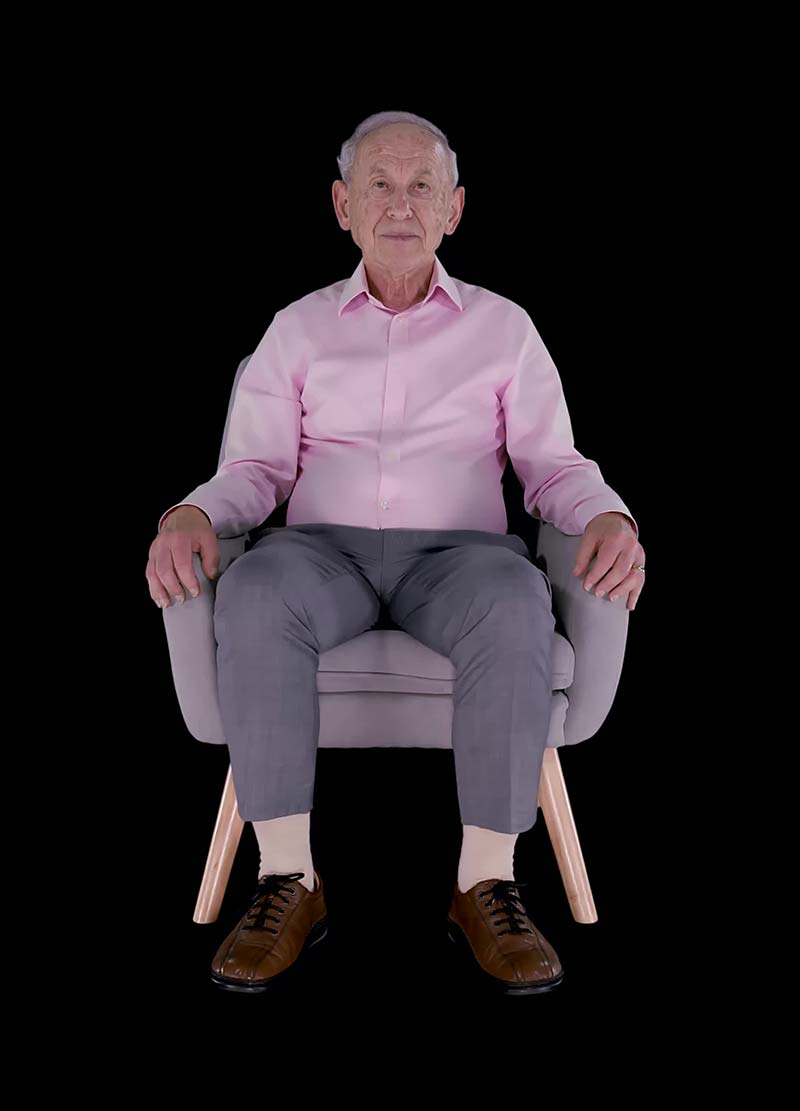
Edith Eger
Interviewed in English in 2022 in association with the Seed the Dream Foundation in Oceanside, California.
Edith Eva Eger is a survivor of the Holocaust who lives in La Jolla, California. Edith was born Edith Elefant in Kosice, Czechoslovakia, on September 29, 1927 to parents Lajos and Ilona Elefant. Her older sister, Klara, was a skilled musician while Edith excelled in ballet and gymnastics. When Hungary occupied Kosice in 1938, Edith’s father was conscripted to a Hungarian forced labor battalion and nearly killed. In 1944, after the Germans occupied Hungary, the family was sent to the brick factory that acted as the ghetto of Kassa. They stayed there approximately two months before being sent to Auschwitz-Birkenau via cattle car.
Upon deportation to Auschwitz in May of 1944, Edith and Magda were separated from their mother, father, and grandparents. They never saw them again. Over the following months, the sisters were transported to multiple labor camps and factories, surviving an ally-bombed train and a death march. American troops liberated both Edith and Magda at Gunskirchen on May 4, 1945.
The two journeyed back to Kosice and reunited with Klara, who had survived the Holocaust in Budapest. While recuperating at a tuberculosis hospital in the Tatra Mountains, Edith met her future husband Bela Eger. In 1949, Edith and her family escaped from communism and lived in Vienna before immigrating to the United States. Edith studied psychology and earned her PhD. Today, she lives in La Jolla, California, having taught at UCSD for many years as well as authored two books.

Max Eisen
Interviewed in English in 2019
Max Eisen was a survivor of the Holocaust who lived in Toronto, Canada, when we recorded him for Dimensions in Testimony. Max was born Tibor Eisen in Moldava, Czechoslovakia in 1929 to an Orthodox family. He had two younger brothers, and a sister born during the war in 1943. When Czechoslovakia was partitioned in 1939, Hungarians occupied his town on his 10th birthday, immediately changing life in all ways. His family was deported in May 1944 for Birkenau, and all–save Max, his father, and his uncle–were immediately selected to the gas chambers. Max, his father, and his uncle worked as slave laborers until July 1944 when they were selected out, leaving Max as the sole survivor. Max then worked in the medical barracks of Auschwitz I under Dr. Orzeszko, a Polish political prisoner and chief surgeon of Auschwitz. In January 1945, he was sent on a death march to Mauthausen. From Mauthausen he was taken to Melk, and then to Ebensee, where he was liberated at Ebensee on May 6, 1945 by the 761st Black Panther Tank Battalion of the American army. After the war, he made his way back to Czechoslovakia and stayed until the Communist coup in 1949. Max immigrated to Canada in 1949, where he later met and married Ivy in 1952. They had twin sons. Max published his memoir in 2016, By Chance Alone. Max passed away in 2022.
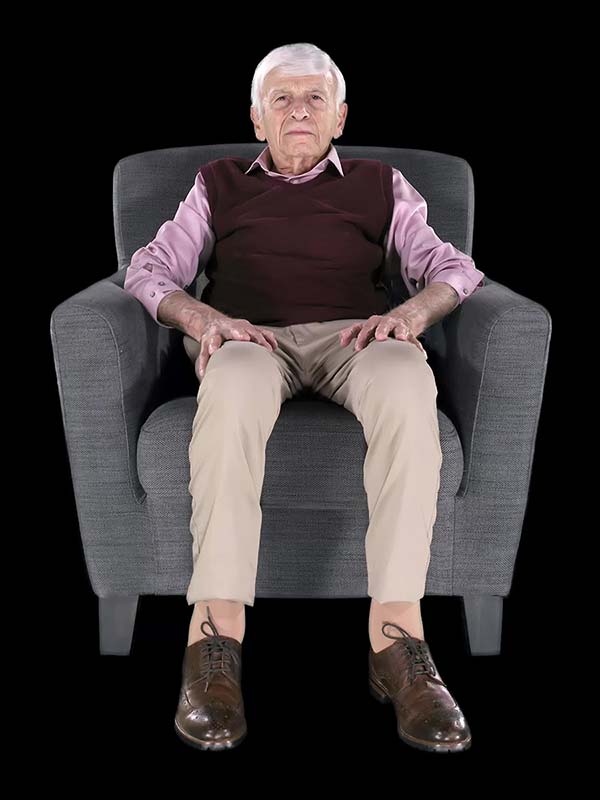
Aaron Elster
Interview in English in 2015 in association with Illinois Holocaust Museum and Education Center
Aaron Elster was a survivor of the Holocaust who lived in Chicago, Illinois. Aaron was born in Sokolow Podlaski, Poland and was 6 years old when the war started. He, along with his parents and two sisters were forced into a ghetto in their hometown where they lived for two years. As the ghetto was liquidated, Aaron fled and was able to reunite with his mother. Aaron’s mother had arranged for a Polish family, the Gurskis, to take in Aaron’s older sister. Aaron’s mother told him to go to the Gurskis who agreed to hide him in their attic; that was the last time he saw his mother. He lived in hiding for two years until he was liberated by the Soviet Army in 1945. After the war, Aaron’s Uncle Sam (who had fought for the Russian Partisans during the war) arrived in Sokolow Podlaski to take care of Aaron and his sister. From 1945-46, the three of them went through a series of DP camps in Germany. In 1947, Aaron and his sister left Germany for the United States, arriving in New York and eventually settling in Chicago. In 1954, he joined the U.S Army and fought in the Korean War. He married Jacquline in 1954 and they had two sons. He was an active member of the Skokie survivor community, serving as the Chairman of the Speakers’ Bureau and Vice President at the Illinois Holocaust Museum and Education Center. Aaron passed away at the age of 85 in 2018.
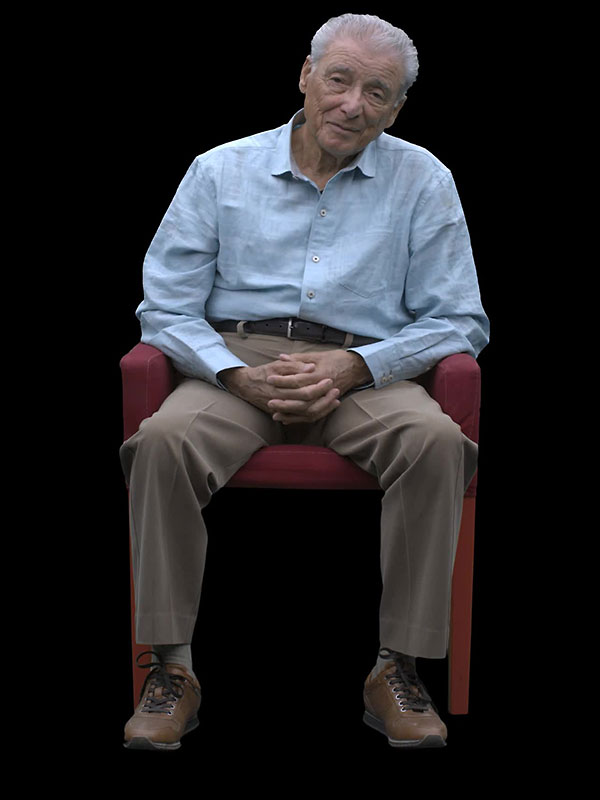
Yvonne Engelman
Interviewed in English in 2020 in association with the Sydney Jewish Museum in Sydney, Australia.
Yvonne Engleman was a survivor of the Holocaust who lived in Sydney, Australia. Yvonne was born Ibolsa Engel on October 9, 1927 to loving parents Rachel and Shlomo Engel in Dovhoje, Czechoslovakia (now Dovhe, Ukraine). The town, framed by the Carpathian Mountains, held a small population of integrated Orthodox Jews. Yvonne attended public schools, had many Jewish and non-Jewish friends, and never encountered antisemitism until the Hungarians invaded in 1938.
Life changed quickly after the Hungarians took control. Yvonne and her family were subjected to harassment, violence, and intensifying restrictions. During Passover in 1944, all 110 Jewish families in Dovhoje were rounded up and sent, possessionless, to the ghetto in the nearby city of Berehowe. After weeks of living in a former brick factory, Yvonne and her family were deported to Auschwitz, where Yvonne was separated from her family. The last thing Yvonne’s father ever said to her was to make her promise that she would survive. She was 16.
At Auschwitz, Yvonne was made to sort out valuables from incoming inmates. Later, she was sent to work in Peterswaldau, Germany, where she built clocks for bombs. Yvonne survived starvation, illness, air raids, and death-march selections. After the Soviet army liberated her camp in 1945, Yvonne traveled to Prague and Paris before immigrating to Australia with her future husband John Engelman in 1948. The couple were married in May 1949, the first pair of survivors to marry in Australia. Yvonne had three children, nine grandchildren, and quite a few great-grandchildren. Yvonne passed away in 2025.

Kuba Enoch
Interviewed in English in 2021 in association with the Sydney Jewish Museum in Sydney, Australia.
Jacob ‘Kuba’ Enoch was a survivor of the Holocaust who lived in Sydney, Australia. Kuba was born on May 3, 1926 in Krakow, Poland, to Chaskel and Pepka Enoch. Kuba and his younger brother Zigmund, 'Ziggy', grew up in a Jewish household and attended a Jewish day school.
When the war started in September, 1939, Kuba and his father tried and failed to escape Krakow. Days later, the process of expelling Jews from Krakow began. The Enoch family was required to wear identification bands months before their own expulsion. The family stayed at a nearby farm until 1941, when they were moved into the overcrowded Krakow ghetto. Kuba, Ziggy, and their parents remained until March, 1943, when the workers of Krakow ghetto were forced to the nearby camp of Plaszow. Kuba’s mother tried to smuggle Ziggy out before the move, but a guard caught him. When working at a laundry in Plaszow, she found Ziggy’s clothes, confirming his death.
Over the following two years, Kuba survived Plaszow, Ostrowiec, Auschwitz-Birkenau, Auschwitz-Buna, a death march, and Buchenwald. Liberation came for him on April 11, 1945. After liberation, Kuba moved to Switzerland and learned that his father, aunt, and uncle survived. Wanting to be as far away from Europe as possible, Kuba left for Australia and settled in Sydney around October of 1948. He began working as a mechanic, and met and married his wife Kitty. Kuba had four children, eleven grandchildren and ten great-grandchildren. He passed away in 2021.

Henry Fenichel
Interviewed in English in 2023 in association with The Nancy and David Wolf Holocaust & Humanity Center in Cincinnati, Ohio.
Henry Fenichel is a survivor of the Holocaust who lives in Cincinnati, Ohio. Henry was born on April 13, 1938 in The Hague, Netherlands. His parents, Moritz and Paula, were Polish immigrants. Henry’s father owned a pet and flower shop, and his mother was a dressmaker.
In July 1942, after the German Army occupied Holland, Henry’s father was rounded up, imprisoned, and deported to Mauthausen. Henry, only 4 years old, and his mother went into hiding in a local convalescent home. They were discovered within the year, arrested, and sent to the Amsterdam ghetto. In May 1943, Henry and his mother were deported to Westerbork, one of two transit camps in the Netherlands. In February, cattle cars delivered them to the Bergen-Belsen concentration camp. Henry’s mother was able to secure them a place on Transport 222, the prisoner exchange of 222 Dutch Jews from Bergen-Belsen for 222 German Templars from the British Mandate of Palestine. They arrived in Palestine on July 10th, 1944.
After the war, Henry’s mother remarried, and the family immigrated to the United States. They arrived in New York on January 14th, 1953, and moved into Brooklyn. Henry finished his schooling and attended Brooklyn College, where he met his wife, Diana. They had two daughters and moved to Cincinnati in 1965, where Henry taught as a professor of physics at the University of Cincinnati for 40 years.

Ben Ferencz
Interviewed in English in 2020
Ben Ferencz was an American lawyer, known especially for his work as an investigator of Nazi war crimes and as the chief prosecutor at the Einsatzgruppe Trial at Nuremberg.
Benjamin Berell Ferencz was born in 1920 in Transylvania, and immigrated with his family to Hell’s Kitchen of New York shortly after. After graduating Harvard Law School, in World War II he joined an anti-aircraft artillery battalion in the United States Army and served under General Patton. Near the end of the war, he was assigned to the Army’s war crimes division and was tasked with collecting evidence from the newly liberated concentration camps.
While he was honorably discharged after the war, he soon returned to Europe to join as the chief prosecutor at the Einsatzgruppe Trial at Nuremberg. He remained in Germany for a decade with his wife Gertrude and four children, and was key in organizing reparation and rehabilitation.
After practicing private law in the United States for some time, Ferencz focused on fighting atrocity crimes in the world. He advocated for the establishment of international law and the International Criminal Court, and has worked with the United Nations. Prior to passing, he continued to speak out against violence, war, and injustice. Ben was 103 when he passed away on April 7, 2023.
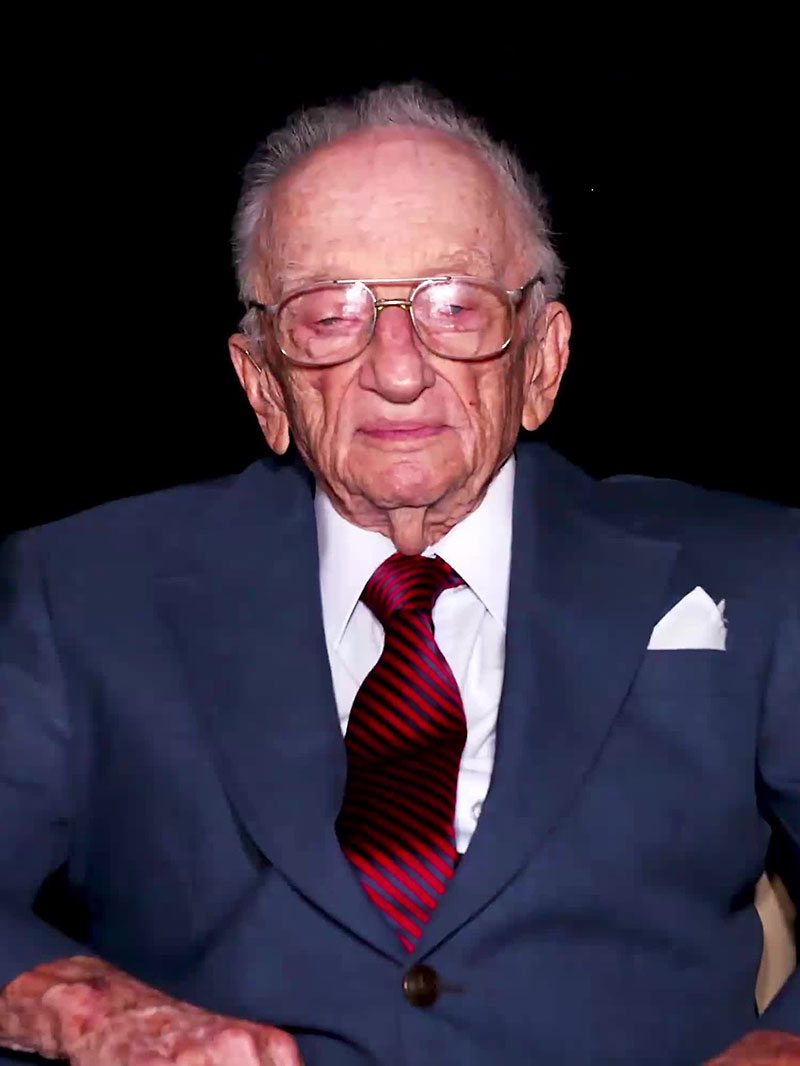
Renée Firestone
Interview in English in 2015
Renee Firestone is a survivor of the Holocaust who now lives in Los Angeles, California. Renee Firestone was born Renee Weinfeld in 1924 in Uzhorod, Czechoslovakia. She had an older brother, Frank, and a younger sister, Klara. The family was not very religious and her father made his living in the textile business. After years of Hungarian occupation, Renee and her family were sent to a ghetto in 1944. They were subsequently deported to Auschwitz II-Birkenau shortly after. Upon arrival in the camp, Renee’s mother was killed. Renee and her sister were sent to Birkenau. After a selection, Klara was chosen for experiments and Renee never saw her again. Renee was taken on a death march in the winter of 1944 to Liebau. She was liberated by the Russians in 1945. After the war, she returned to Prague where she was reunited with her brother Frank who had survived the war by fighting with the Partisans. The two of them found out that their father was very ill with tuberculosis in Theresienstadt. They had him transferred to a hospital to receive medical care, but he died soon after. Renee married Holocaust survivor Bernard Firestone in 1946 and they had a daughter born soon after. In 1948, the Firestones moved to the United States, eventually settling in Los Angeles, California. Renee become a well-known fashion designer and became involved with the Simon Wiesenthal Center and Museum of Tolerance in Los Angeles and the Los Angeles Museum of the Holocaust.
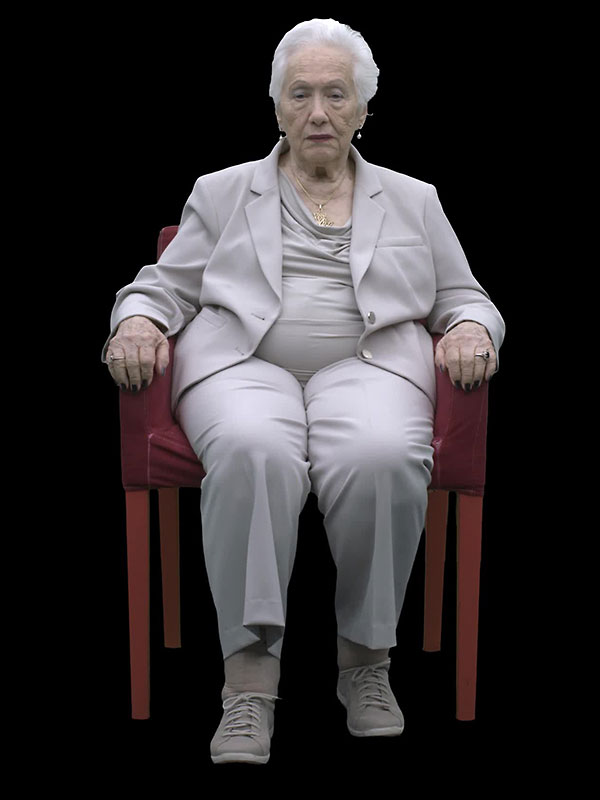
Fritzie Fritzshall
Interview in English in 2015 in association with Illinois Holocaust Museum and Education Center
Fritzie Fritzshall was a survivor of the Holocaust who lived in Chicago, Illinois, at the time we recorded her for Dimensions in Testimony. Fritzie was born Fritzie Weiss in Klucharky, Czechoslovakia. She lived with her mother and two younger brothers; her father had immigrated to the United States in order to provide a better life for his family. In 1944, the Germans invaded Fritzie’s hometown and she and her family were forced into a ghetto. Shortly after, she and her family were deported to Auschwitz II-Birkenau, where her mother and two brothers were murdered. Fritzie worked as a slave laborer in the camp for nearly a year before being sent on a death march to Germany. She managed to escape the death march and was liberated by the Soviet Army in the spring of 1945. After the war, she moved to the United States in 1946 and reunited with her father. She eventually settled in Chicago, became a hairdresser, and married Norman Fritzshall. They have one son. She served as the President of the Illinois Holocaust Museum and Education Center. Fritzie passed away in 2021.
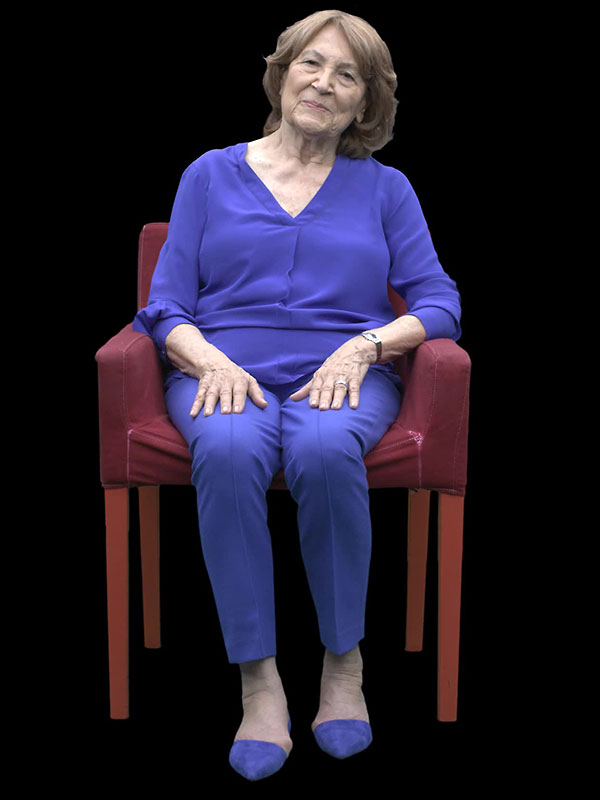
Salpi Ghazarian
Interviewed in English in 2024 in Los Angeles, California.
Salpi Haroutinian Ghazarian is a descendent of Armenian Genocide survivors who lives now in Los Angeles, California. Her maternal and paternal grandparents survived the deportations of 1915 and found themselves in Aleppo, Syria. Salpi was born in Aleppo on July 26, 1955. In 1964, the family moved to the United States. During her career, Salpi held several prominent positions, including editor and publisher of The Armenian International Magazine (AIM), West Coast Coordinator of the Zoryan Institute for Contemporary Armenian Research and Documentation, and Special Assistant to the Foreign Minister of Armenia. She was also the cofounder and director of the Civilitas Foundation, which launched the trilingual news channel CivilNet. In 2015, she joined the Institute of Armenian Studies at USC, first as Director and later as Special Initiatives Director, a role she held until her retirement in April 2024.

Max Glauben
Interview in English in 2018 in association with Dallas Holocaust and Human Rights Museum
Max Glauben was a survivor of the Holocaust who was living in Dallas, Texas, when we recorded him for Dimensions in Testimony. Max was born Moniek Glauben in Warsaw, Poland in 1930. He had a younger brother and two parents. His father owned a Yiddish newspaper called the Tageblatt. In 1939, the Nazis invaded Poland and persecutions of Warsaw’s Jewish population began. The Warsaw Ghetto was established around the neighborhood in which Max and his family lived. Max and his father started smuggling items in and out of the ghetto. In 1943, the Warsaw Ghetto Uprising began near their home; Max and his family went into hiding for several weeks during the Uprising but they were eventually found by the Nazis. They were sent to Majdanek where Max’s mother and younger brother were immediately sent to the gas chambers. Max and his father were sent to work for an airplane factory in Budzyn. His father was killed in Budzyn. Max began working in an airplane factory pattern shop for a Nazi named Keller. Max spent the war working with Keller in Mielec, Wieliczka, Plaszow, and Flossenburg. On a death march from Flossenburg to Dachau the Nazi guards fled and Max was picked up and liberated by the American Army in 1945. After the war, Max moved to the U.S. in 1947. Max was drafted into the U.S. Army in 1951 and was sent to Fort Hood. In 1953, he received an honorable discharge from the U.S. Army and he moved to Dallas, Texas. He married Freida in 1953. The Glaubens had three children and Max began working with Frieda’s brother in Imperial Garment Supply. Max passed away in 2022.

Mona Golabek
Interviewed in English in 2021 in association with the Hold on To Your Music Foundation in London, UK.
Mona Golabek is the child of a Holocaust survivor who lives today in Los Angeles, California. Mona was born in Los Angeles to her parents, Lisa Jura and Michael Golabek. Lisa was a concert pianist and Michael was a French resistance fighter. Both had lost many family members during the Holocaust.
Lisa Jura was a child piano prodigy from Vienna, Austria, who survived the Holocaust thanks to the Kindertransport. She arrived in England as a refugee in 1938 and was able to continue pursuing her love of music. Mona and her sister Renee grew up playing the piano with their mother and hearing about her experiences. Inspired by her mother, Mona went on to study music at the Juilliard School of Music and the Peabody Conservatory of Music, as well as under private teachers in Rome and London. She has led an acclaimed and prolific career as a musician.
In 2003, Mona co-authored a book about her mother’s experiences titled “The Children of Willesden Lane.” She also founded the non-profit foundation Hold on To Your Music, dedicated to sharing her mother’s story with others worldwide. In 2012, Mona was featured in the one-woman show “The Pianist of Willesden Lane,” an adaptation of the book. The show has had sold-out theater runs in venues across the world. Today, Mona is continuing to spread her mother’s story to students and families with the power of music.
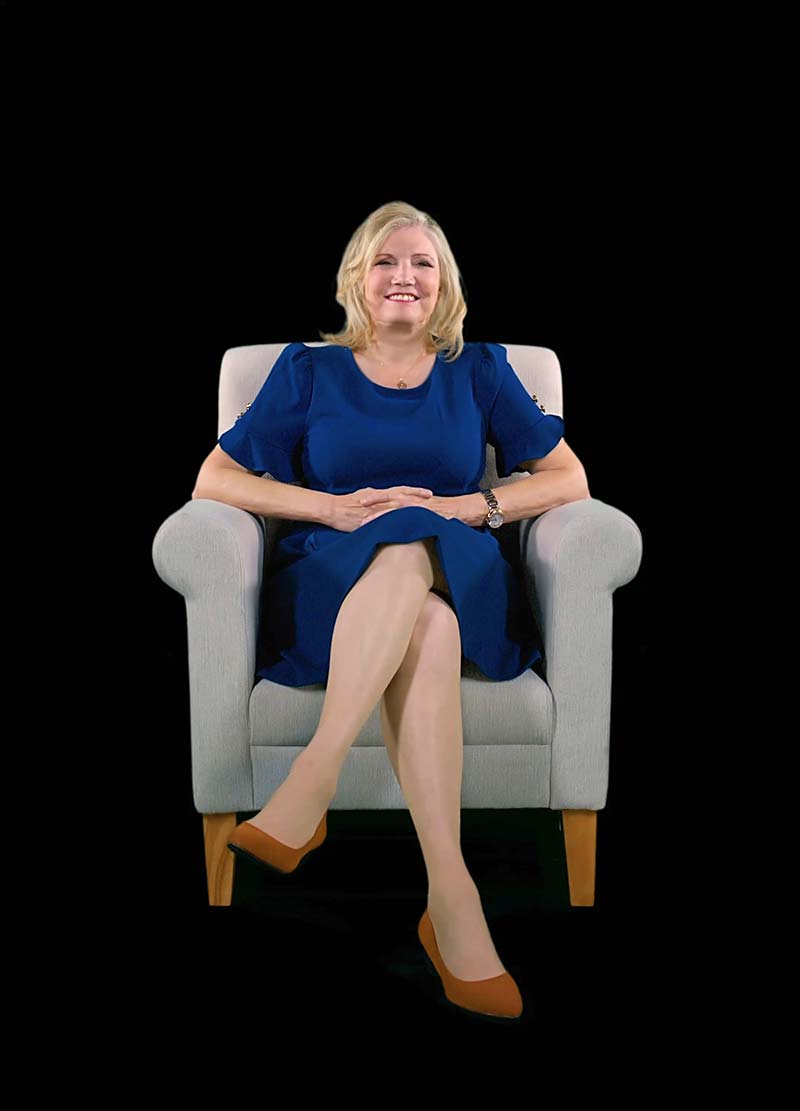
Manfred Goldberg
Interviewed in English in 2021 in association with the Holocaust Educational Trust in London, UK.
Manfred Goldberg is a survivor of the Holocaust who lives in England. Manfred was born on April 21, 1930 in Kassel, Germany. His parents, Baruch (Benno) and Rosa, were both Polish Jewish immigrants and had many friends. Manfred and his younger brother, Hermann, grew up alongside the Nazi regime’s rise to power. He recalls escalating persecution for years before the war.
In August, 1939, after a near-lethal arrest and months spent hiding, Manfred’s father was able to flee to England. The war broke out two weeks later, meaning Manfred, Hermann, and their mother could not follow. On December 9, 1941, the three were deported by train to the Riga Ghetto in Latvia. The living conditions were miserable and accompanied by constant fear. In spite of the difficulties, Manfred still got to celebrate his Bar Mitzvah.
In August, 1943, the family was moved to a labor camp. Manfred and his mother were selected to work on a slave labor railway gang, repairing damaged railway sections. One day, the pair returned to find Hermann missing. Manfred never saw him again. He and his mother continued as slave laborers, surviving the Stutthof concentration camp, Stolp labor camp, Burggraben, and a death march. They were liberated at Neustadt on May 3, 1945 by the British troops. Manfred was able to go to Britain and reunite with his father in September of 1946. Since then, he has graduated from London University with a degree in Electronics, met and married his wife Shary, and raised four sons and several grandchildren. Manfred passed away in 2025 at 95.

Betty Grebenschikoff
Interviewed in English in 2021 in association with the Florida Holocaust Museum in St. Petersburg, Florida.
Betty Grebenschikoff was a survivor of the Holocaust who lived in St. Petersburg, Florida. Betty was born Ilse Margot Kohn in Berlin, Germany, on December 23, 1929. She, along with her father Max, her mother Olga, and her older sister Edith, were pushed out of their home by Nazis in 1938. Betty recalls being forced to take the middle name “Sara” alongside all other Jewish women in her community. Spurred by the violence of Kristallnacht, and seeking refuge that would accept their undocumented status, the family escaped to Shanghai, China, in 1939.
In Shanghai, the Kohn family started a life in the Hongkew district. Shortly after the attack on Pearl Harbor in 1941, the occupying Japanese army forced the family, alongside all other Jews, into a segregated area known as the “Shanghai Ghetto.” They were liberated by US troops in August 1945. It was only then that Betty and her family learned of what had happened in Europe, and that much of their extended family had been killed.
Betty met Russian immigrant Oleg Grebenschikoff, and the couple married in 1948. They relocated to Sydney, Australia, in 1950, and had two daughters. The family of four then emigrated to the US in 1953, where Betty and Oleg had three more children. Betty led a career as a secretary to various hospitals and pharmacies, and published her memoir “Once My Name Was Sara” in 1993. In 2021, Betty reunited with a childhood friend Ana Maria Wahrenberg, 81 years after the pair had last seen one other in a Berlin schoolyard. Betty passed away in 2022.

Pinchas Gutter
Interviewed in English in 2014
Pinchas Gutter is a survivor of six German Nazi concentration camps who now lives in Toronto, Canada. Pinchas was born in Łódź and was 8 years old when the war started. He, along with his twin sister and entire family fled to Warsaw, where they were confined in the Warsaw Ghetto for two and a half years. They were captured in April 1943 and deported to Majdanek death camp. When the family arrived at the camp, Pinchas' father, mother, and sister were murdered by the Nazis. After Majdanek, Pinchas was sent to Skarzysko-Kamienna, Czestochowa, Buchenwald, Colditz, and Theresienstadt. He was liberated in Theresienstadt by the Soviet Army on May 8, 1945. After the war, Pinchas was taken to orphanage in England that was run by UNRRA. In 1948 when he was living in London, a cousin in Paris discovered he was alive and invited him to live in Paris. He left Paris in 1950 and went to Israel where he volunteered for the army. After three years in the army, he worked for a textile factory. He left his work in the factory to go to school and learn Hebrew. As he was learning Hebrew, he met his wife, Dorothy. They moved to England and married there. He was then offered a job in Brazil and he lived in Sao Paolo for a year. Pinchas and Dorothy moved to South Africa after Brazil, and lived there until 1985 when they moved and settled down in Toronto. Pinchas and Dorothy had three children: two daughters and a son. Pinchas is still an active member of his community, serving as a cantor in his synagogue, and he still speaks and shares his story today.
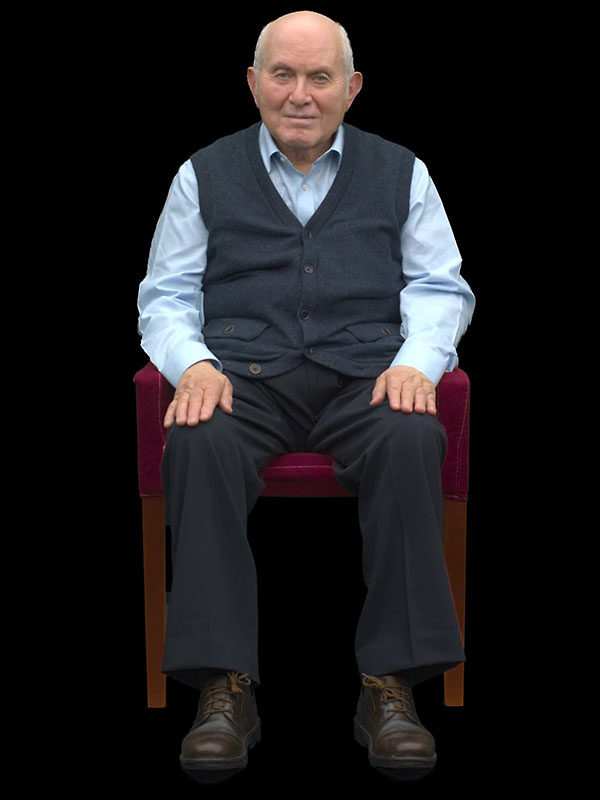
Sam Harris
Interviewed in English in 2015 in association with Illinois Holocaust Museum and Education Center
Sam Harris is a survivor of the Holocaust who lives in Chicago, Illinois today. Sam was born Szlamek Rzeznik in Demblin, Poland to a large Orthodox family. Sam was 4 years old in 1939 when the war began in Demblin. Sam, his seven siblings and his parents were forced to move into the ghetto. They lived there for almost three years before the ghetto was liquidated in 1942. Sam’s entire family with the exception of his sisters Sara and Rosa, were deported to Treblinka and murdered in the gas chambers. Rosa, Sam’s older sister, worked as a slave laborer in the concentration camp outside of Demblin and she was able to hide both Sam and his sister Sara in the camp. In 1944, Sam, Rosa, and Sara were transported to Czestochowa where Rosa was again able to hide her two siblings. The three of them were liberated by the Soviet Army in 1945. Rosa and the husband she had married in Demblin, Walter, left for Austria to find remaining members of his family. Sam and Sara were placed in an orphanage. In 1946, Rosa smuggled out both Sam and Sara to Austria and arranged for both of them to move to New York City. The two siblings moved to the United States in 1947 and both were adopted by two different families. Sam was adopted by the Harris Family and he moved to Chicago. After graduating from college, he worked for Equitable Life Insurance and married Janice (‘Dede’). They had two children. Sam is still active member of the survivor community in Chicago and played an instrumental role in helping to build the Illinois Holocaust Museum and Education Center, of which he is President.
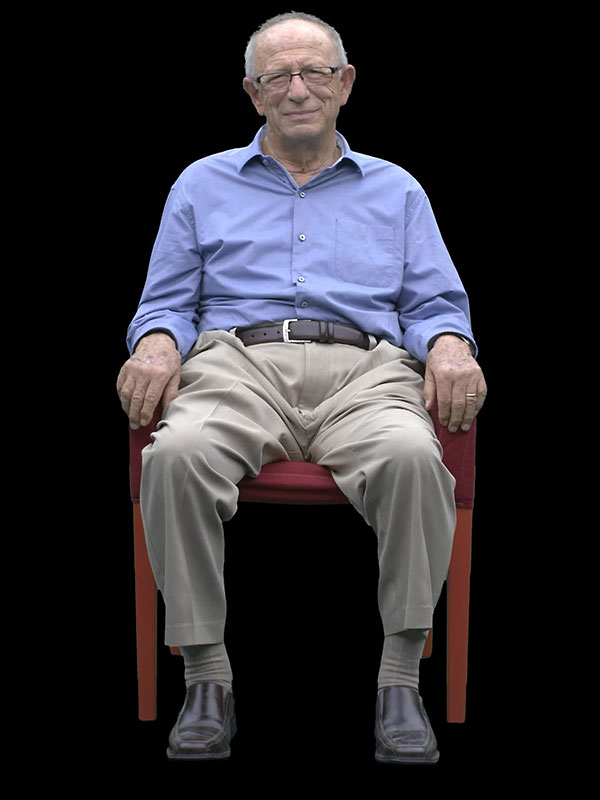
Ed Herman
Interviewed in English in 2021 in association with the Florida Holocaust Museum in St. Petersburg, Florida.
Edward Herman is a survivor of the Holocaust who lives in St. Petersburg, Florida. Ed was born Emanuel “Emil” Herman in Warsaw, Poland, in 1931. Ed comes from an upper-class Jewish family and has one sister, Helen. His family moved to Katowice when Ed was one year old, but escaped back to Warsaw when the war started in 1939.
After the Germans reached Warsaw, Ed’s father, who was serving in the Soviet army, attempted to bring the family to the Soviet-controlled area of Poland. Ed’s mother, however, refused to leave. The family remained as the Warsaw Ghetto was constructed around them. When the Germans began liquidating the ghetto, Edward hid in the attic of a Christian family’s home. The family escaped in the spring of 1942, and Ed’s mother arranged for him to be smuggled out of Poland in September of 1943.
When Ed reached Budapest, his guide abandoned him. He was left to live on the streets, and then in an orphanage in Vác. His aunt and uncle helped take care of him until liberation in 1944. Ed reunited his mother and sister at the end of 1945. Ten years later would see him reuniting with his father, as well. Ed emigrated to Canada in 1954 where he received his doctorate in economics, married his wife Halina, and raised two children. In 1964, the family moved to the United States, where Ed and Halina have been active in Holocaust education since.
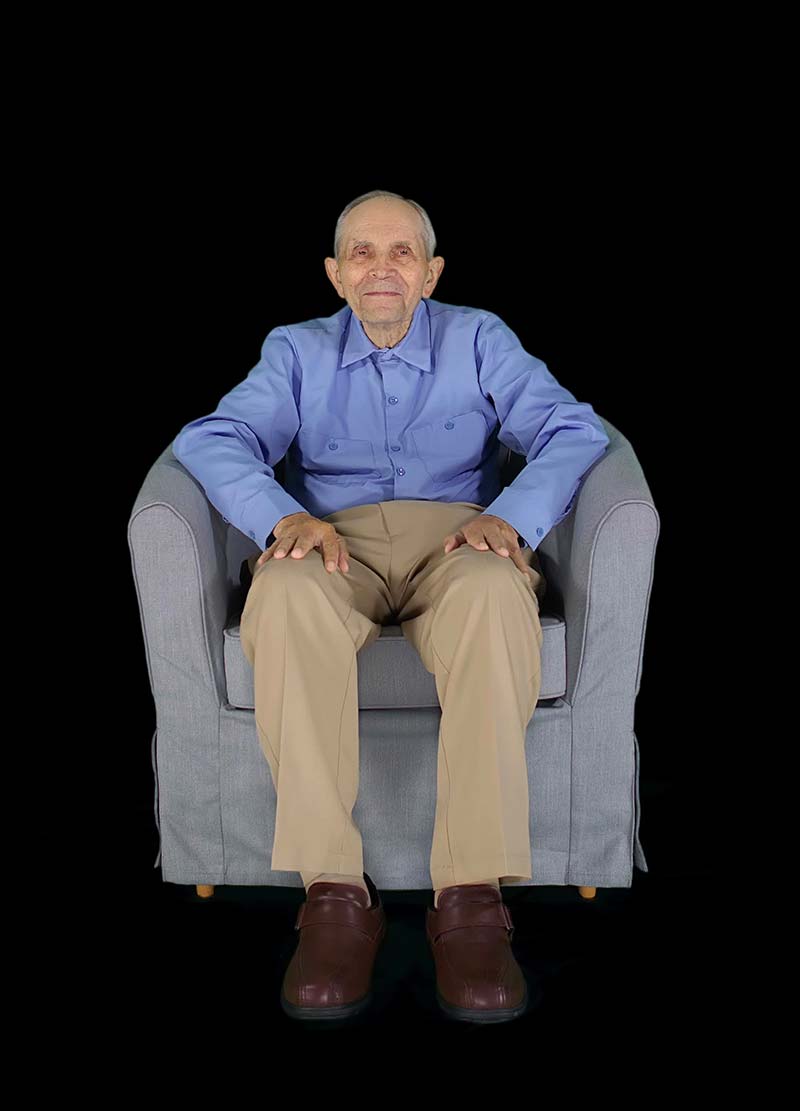
Olga Horak
Interviewed in English in 2020 in association with the Sydney Jewish Museum in Sydney, Australia.
Olga Horak was a survivor of the Holocaust who lived in Sydney, Australia. Olga was born Olga Rosenberger on August 11, 1926 in Bratislava, Czechoslovakia (now Slovakia). Her parents, Hugo and Piroshka, came from well-to-do Orthodox families. Despite keeping strict observance of shabbat and kashrut, they never once let Olga or her sister Judith miss school for the holidays.
Olga was 14 years old when the Nazis took over. The anti-Jewish laws forced Olga to wear the yellow star in an increasingly hostile environment. After Olga’s sister was deported to Auschwitz in 1942, Olga’s parents took their remaining daughter and fled to Hungary. Lack of Hungarian papers saw them return to Bratislava after a year. A neighbor took the family in before turning on them and denouncing them.
Olga and her parents were first taken to Sered, and then Auschwitz-Birkenau, in the summer of 1944. In Auschwitz, Olga’s father was separated from her and her mother. As with Judith, Olga never saw him again. Come winter, Olga and her mother were transported to the Kurzbach concentration camp. Their stay culminated in a death march towards Bergen-Belsen. There, they were liberated on April 15, 1945. Upon liberation, Olga’s mother collapsed and passed away.
After several months of recovery, Olga returned to Bratislava. She met her husband, a fellow survivor named John Horak, in 1947. The two immigrated to Sydney, Australia in 1949. Olga and John have two daughters, three grandchildren, and three great grandchildren. Olga was involved in setting up the Sydney Jewish Museum, where she had been a volunteer guide for a long time. Olga passed away in 2024.

Ani Hovannsian
Interviewed in English in 2025 in Los Angeles, California.
Ani Hovannisian is a descendant of Armenian Genocide survivors. She was born on November 17, 1964, in Fresno, California. Her grandparents survived the Armenian Genocide and eventually settled in California. Ani’s father, Dr. Richard Hovannisian, was a distinguished historian and professor at UCLA, renowned for his extensive works on Armenian history and establishing the largest collection of oral history interviews with Armenian Genocide survivors. Ani is a filmmaker and documentary producer. In 2021, she premiered The Hidden Map, a documentary chronicling her journey through Historic Armenia to uncover remnants of Armenian history and culture in ancestral lands located in present-day Turkey. She continues to speak to students and diverse audiences about Armenian history, culture, and the enduring legacy of her family.
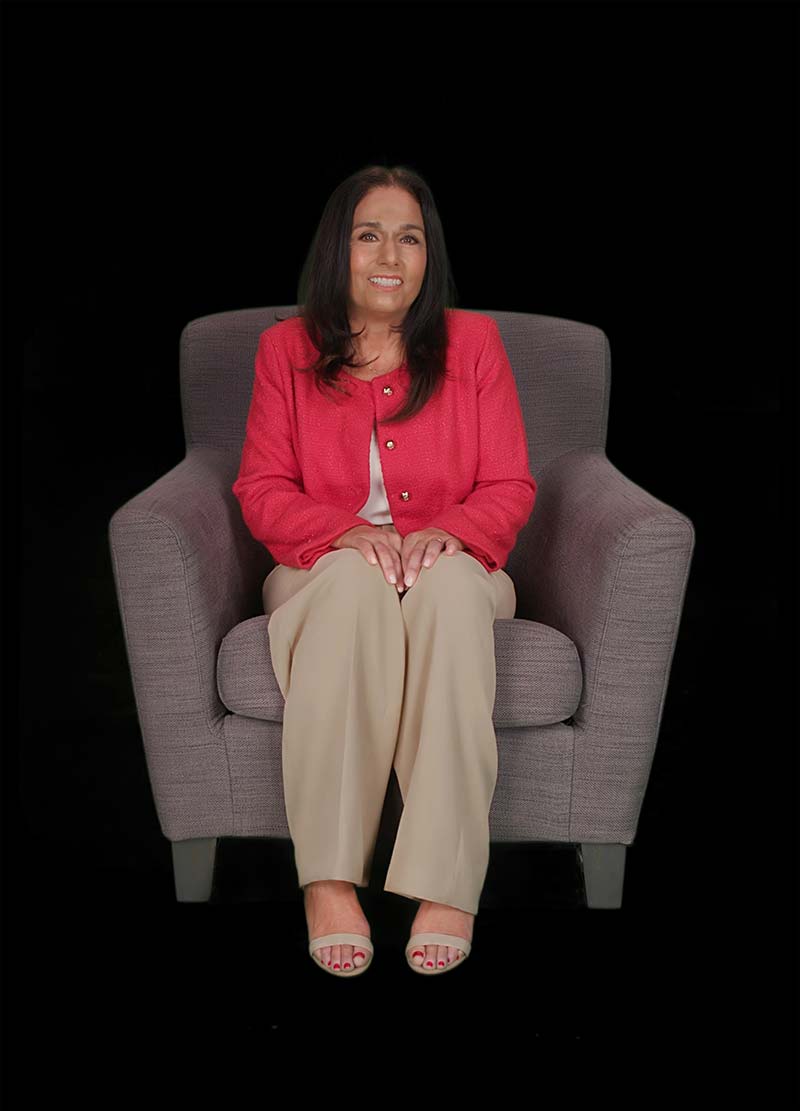
Eddie Jaku
Interviewed in English in 2021 in association with the Sydney Jewish Museum in Sydney, Australia.
Eddie Jaku was a survivor of the Holocaust who lived in Sydney, Australia. Eddie was born Abraham Salomon Jakubowicz on April 14, 1920 in Leipzig, Germany. Eddie and his mischievous younger sister, Henni, had a large extended family. Their mother, Lena, had 12 siblings. Their father, Isidore, had 3. Eddie recalls a happy childhood with birthday celebrations for an aunt, uncle, or cousin almost every week.
Eddie was not quite 13 years old when Hitler came to power in 1933. Like the other 26,000 Jews in Leipzig, Eddie’s family was shunned from society and persecuted. When Eddie was barred from going to school as a Jewish child, his family sent him away to an orphanage under a false identity where he spent 5 years completing his basic schooling, working making x-ray equipment, and studying engineering.
On November 9th, 1938, Eddie returned to Leipzig to surprise his parents for their 20th anniversary. He found no one home. Unknowingly, Eddie had returned on the eve of Kristallnacht. He was beaten, arrested, and sent to a concentration camp in Buchenwald. Over the following 7 years, Eddie survived four different camps and staged several escapes
After the war, Eddie met and married his wife Flore in Belgium in 1946. They immigrated to Sydney, Australia, in 1950. His autobiography, The Happiest Man on Earth, was released that same year in honor of his 100th birthday. Eddie passed away in 2021 a father, grandfather, great-grandfather, storyteller, peace-advocator, and happy man.

Helen Kahan
Interviewed in English in 2021 in association with the Florida Holocaust Museum in St. Petersburg, Florida.
Helen Kahan is a survivor of the Holocaust who lives in St. Petersburg, Florida. Born as Hani Sabo in Rozavlea, Romania, in 1923, Helen is the oldest of seven children. When she was 17 years old, Helen moved to Budapest, Hungary, alongside her brother Huna. The two worked there as a seamstress and goldsmith until the Nazis moved in on Hungary in 1944. When Helen returned to help her parents in Rozavlea, they were forced into the ghetto and then sent to Auschwitz-Birkenau.
Over the course of the war, Helen was a prisoner in the Auschwitz-Birkenau and Bergen-Belsen concentration camps, as well as the Lippstadt airplane factory. As the war was ending, Helen was forced on a death march out of Lippstadt. She escaped and was liberated on May 9, 1945 in Oschatz, Germany. The next year of her life was spent recovering in hospitals before returning to Romania to search for her family. Helen found that aside from her brother Huna and sister Miriam, her entire family had been killed.
Helen later met and married Kolman Kahan. The couple had two children and immigrated to the United States in 1967. Helen lived in New York City, working in the Brooklyn Jewish hospital, until she retired and followed her daughter to Florida. Helen’s family now spans two children, five grandchildren, and 12 great-grandchildren. In 2023, on her 100th birthday, she threw the first pitch at a Yankees-Rays game.

Yetta Kane
Interviewed in English in 2024 in Long Beach, California.
Yetta Kane is a survivor of the Holocaust who lives in Long Beach, California. Yetta was born as Yetta Istrin on December 28, 1932 in Myadzyel, Poland (now Belarus). She grew up in a close-knit, rural community with her parents, Zelik and Edla, and her brothers, Herman and Morris. Yetta also had a sister, Minnie, who unfortunately passed away during childhood. When World War II started, Yetta’s hometown was annexed by the Soviet Union. Yetta, however, recalls an idyllic childhood until the arrival of SS Germans during the summer of 1941.
The Nazis started persecuting and killing Jews immediately. Two of Yetta’s uncles were killed during the first mass shooting in Myadzyel. Soon after, Yetta's family escaped into the woods. The five of them spent about two years in the woods, surviving alongside the Partisan Resistance until they were able to cross the front line. Yetta and her family spent the rest of the war in a Siberian work camp, where Yetta’s younger sister Sara was born.
After the war, all six family members returned to Poland and moved to the Hasenhecke displaced persons camp near Kassel, Germany. They lived there from 1946 to 1949. In November 1949, the family arrived in the United States and settled in Los Angeles. Yetta met her husband, David Kane, a Holocaust survivor from Poland, and the two married in June 1950. Today, Yetta has three children, six grandchildren and nine great-grandchildren. She shares her story, emphasizing the “importance of kindness, education, and treating others fairly.”

Agnes Kaposi
Interviewed in Hungarian in 2021 in London, UK.
Agnes Kaposi is a survivor of the Holocaust who lives in London, England. Agnes was born on October 20, 1932 in Debrecen, Hungary. Her parents, Imre and Magda, were Hungarian-Jewish socialists who faced political and racial discrimination in Hungary’s right-wing political climate. When Agnes was two years old, her parents put her in the care of her grandmother and aunts to go seek work in Budapest. Two years later, Agnes joined them. She attended her first day of school on September 1, 1939 — the day the war started.
When the Nazis invaded Hungary in March of 1944, Agnes and her parents returned to Debrecen. A ghetto was established, and Agnes was put to work making yellow stars. In July of 1944, Agnes and 10 family members were put in a crowded cattle wagon and sent to Auschwitz. For some unknown reason, their train was diverted to Strasshoff, a concentration camp near Vienna. Agnes and her family were forced to labor on a farm and in an armament factory.
Agnes was liberated by the Soviet Army in April, 1945. When she and her parents traveled home, they found their flat occupied and the community hostile to Jews. They ended up settling in Újpest, and struggled to restart their life under the Stalinist regime. Agnes studied Electrical Engineering and married her husband, John. The couple escaped to the UK after the 1956 Uprising and had two daughters. Agnes is a Fellow of the Royal Academy of Engineering, a retired emeritus professor, a published author, and a grandmother of five.

Luna Kaufman
Interviewed in English in 2022 in New York City, New York.
Luna Kaufman was a survivor of the Holocaust who lived in New York City, New York. Luna was born on November 28, 1926 as Amalia Luna Fuss in Krakow, Poland. When Luna was 12 years old, the Nazis invaded Poland. They were soon expelled from the city, forced to live in a neighboring village, forced to wear identifying armbands, and then forced back into the Krakow Ghetto.
When the Nazis liquidated the Krakow Ghetto, Luna and her family were separated. Her father, Marcus, was sent to Auschwitz and her sister, Blanka, was sent to Stutthof. She did not see either of them ever again. Luna and her mother, Maria, were sent to and transferred from several camps: Krakow-Plaszow, Skarżysko-Kamienna, and Leipzig. The two were forced on the death march out of Leipzig, where the Soviet soldiers liberated them.
After liberation, Luna and her mother returned to Krakow where Luna finished her high school education and went on to study Musicology at the Jagiellonian University and Music Conservatory. In 1950, Luna and her mother immigrated to Israel where she married Alex Kaufman, whom she had known in Krakow, in 1951. The next year, in 1952, Luna joined Alex in moving to the USA. They lived in various parts of New York and New Jersey, and eventually settled their family in Watchung, New Jersey. In 1957, Luna’s mother joined Luna in the United States. Luna had three children: Mark, Irene, and Bernice. Luna passed away in 2024.

Oskar Knoblauch
Interviewed in English in 2021 in association with the Arizona Jewish Historical Society in Phoenix, Arizona.
Oskar Knoblauch is a survivor of the Holocaust who lives in Phoenix, Arizona. Oskar was born November 27, 1925 in Leipzig, Germany to a non-observant middle-class family. He lived with his parents, older sister and brother, and uncle. His father and uncle restored furs and were both highly decorated soldiers from World War I. Oskar’s parents were originally from Poland, so as antisemitism began to rise in Germany, the family immigrated to Krakow. When the Nazis invaded Poland in 1939, the family was moved to the Krakow ghetto. Oskar worked on various work details, such as on a nearby farm, while his older family members secured jobs working for the Gestapo.
When Aktions began in earnest around the ghetto, Oskar’s family was able to avoid parts of the violence due to their work for the Gestapo. In 1942, the family narrowly avoided deportation, as a sympathetic Nazi intelligence officer organized for several family members to work at the nearby Montelupich prison. When the ghetto was liquidated in March of 1943, Oskar, his brother, and father were sent to a labor camp called Pomorska. His mother and sister were sent to the Plaszow concentration camp. Oskar’s father died in the camp. Oskar and his brother escaped from the camp just before Krakow was liberated by the Soviet Army in January, 1945. Following liberation, Oskar moved back to Germany, and later to Toronto, Canada where he met his wife Lila. The two moved to the US and eventually ended up in Phoenix, Arizona with their three children.

Charlotte Knobloch
Interviewed in German in 2024 in Munich, Germany in association with the Claims Conference.
Dr. Charlotte Knobloch is a survivor of the Holocaust who lives in Munich, Germany. Dr. Knobloch was born in Munich as Charlotte Neuland on October 29, 1932. She was raised by her father, lawyer and senator Fritz Neuland, and her grandmother, Albertine Neuland. Her early years were pleasant before escalating anti-Jewish laws took away her friends, teachers, and safety. On Kristallnacht, Charlotte witnessed violent arrests, destruction of Jewish businesses, and the burning of her synagogue. Soon after, Charlotte’s grandmother was deported to Theresienstadt, where she perished.
When Charlotte was ten, her father smuggled her to Arberg, a farming village in Franconia, Germany. There, a former housekeeper of the Neuland family named Zenzi Hummel took Charlotte in. Until the end of the war, Charlotte hid as Zenzi’s illegitimate daughter, a Catholic farm girl named Lotte Hummel. At the end of the war, Charlotte reunited with her father. The two returned to Munich, where they began to rebuild Munich’s Jewish community, as well as their own lives. During this time, Charlotte married the late Samuel Knobloch, with whom she raised three children.
Since 1985, Dr. Knobloch has dedicated herself to serving as the President of the Jewish Community of Munich and Upper Bavaria. Additionally, she has held significant leadership roles, including Vice President and President of the Central Council of Jews in Germany, as well as Vice President of both the European Jewish Congress and the World Jewish Congress. She has been recognized and awarded for her distinguished leadership of her community for many years, and uses her position to speak against the problem of continuing antisemitism.

Eva Kor
Interviewed in English in 2016 in association with CANDLES Holocaust Museum and Education Center
Eva Kor was a survivor of the Holocaust who lives in Terre Haute, Indiana. Eva Kor was born Eva Mozes in 1934 in Portz, Transylvania, Romania. She and her twin, Miriam, had two older sisters. The Hungarians later annexed her hometown and her family was sent to live in the town’s ghetto. After living in the ghetto for a few weeks, Eva and her family were deported to Auschwitz II-Birkeanu. The family, with the exception of Eva and Miriam, were gassed upon arrival. The twins were selected by Dr. Josef Mengele for experiments. Eva and Miriam were subjected to daily experiments that often made the girls very ill. Eva and Miriam were liberated by the Russians in January 1945. After the war, Eva and Miriam lived with an aunt in Cluj, Romania from 1945-1950. Eva, Miriam, their aunt and her husband moved to Israel in 1950. In 1952, the twins were drafted into the Israeli Army. In 1960, Eva met fellow survivor Michael Kor and they married in 1960. They moved to Terre Haute, Indiana in 1960 and had a son and a daughter. In 1984, Eva founded the organization C.A.N.D.L.E.S (Children of Auschwitz Nazi Deadly Lab Experiments Survivors) and the CANDLES Holocaust Museum and Education Center in Terre Haute, Indiana. Eva is still very involved with CANDLES Holocaust Museum and Education Center and travels all over the United States, sharing her story with students and organizations. Eva Kor passed away in 2019.
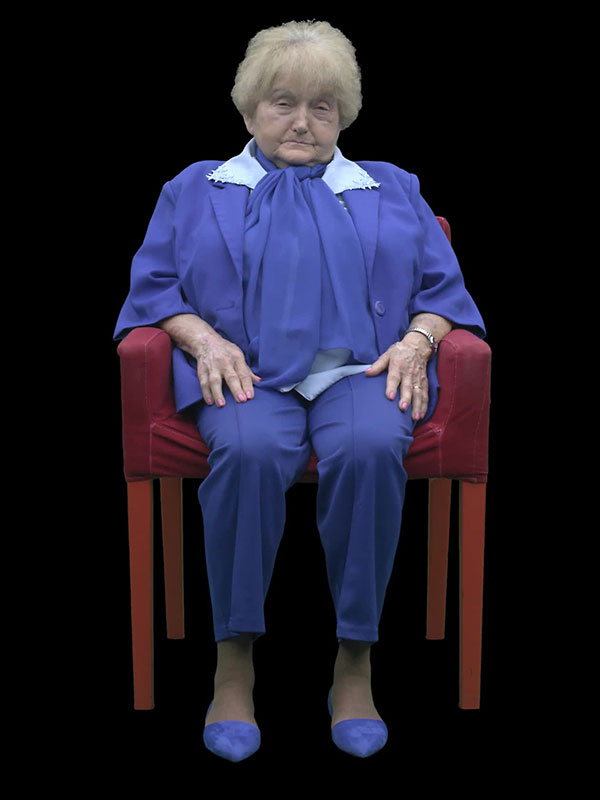
Robert Krell
Interviewed in English in 2022 in association with the Vancouver Holocaust Education Centre in Vancouver, Canada.
Dr. Robert Krell is a survivor of the Holocaust who lives in Vancouver, Canada. Robert was born on August 5, 1940 in The Hague, Netherlands. At the time of his birth, Nazi Germany had already invaded and occupied the Netherlands. His parents, Leo and Emmy Krell, were a young Orthodox Jewish couple with a rich social life. The family experienced severe, escalating restrictions designed to strip away the dignity and resources of the Jewish population.
In 1942, the deportations and rounding up of the Dutch Jewish community began and the Krells went into hiding. At only two years old, Robert was hidden with family friends. The Munnik family took care of Robert as their own child from November 1942 until May 1945. By the time the war was over, Robert had forgotten his biological parents, who had also survived, and had to be convinced of their relation using old photographs. The Krells and Munniks have remained close friends to this day.
In 1951, after years of post-war antisemitism and reminders of lost family, the Krells decided to move to Canada. The trio settled in Vancouver, where Robert’s brother, Ronnie, was born. In 1971, Robert married his wife Marilyn, with whom he had three daughters. Robert has pursued a career as a psychiatrist, focusing on child and family psychiatry. He became a pioneer and expert in child Holocaust survivor memory and has dedicated much of his later life on Holocaust studies and education, including publishing his memoir in 2016.
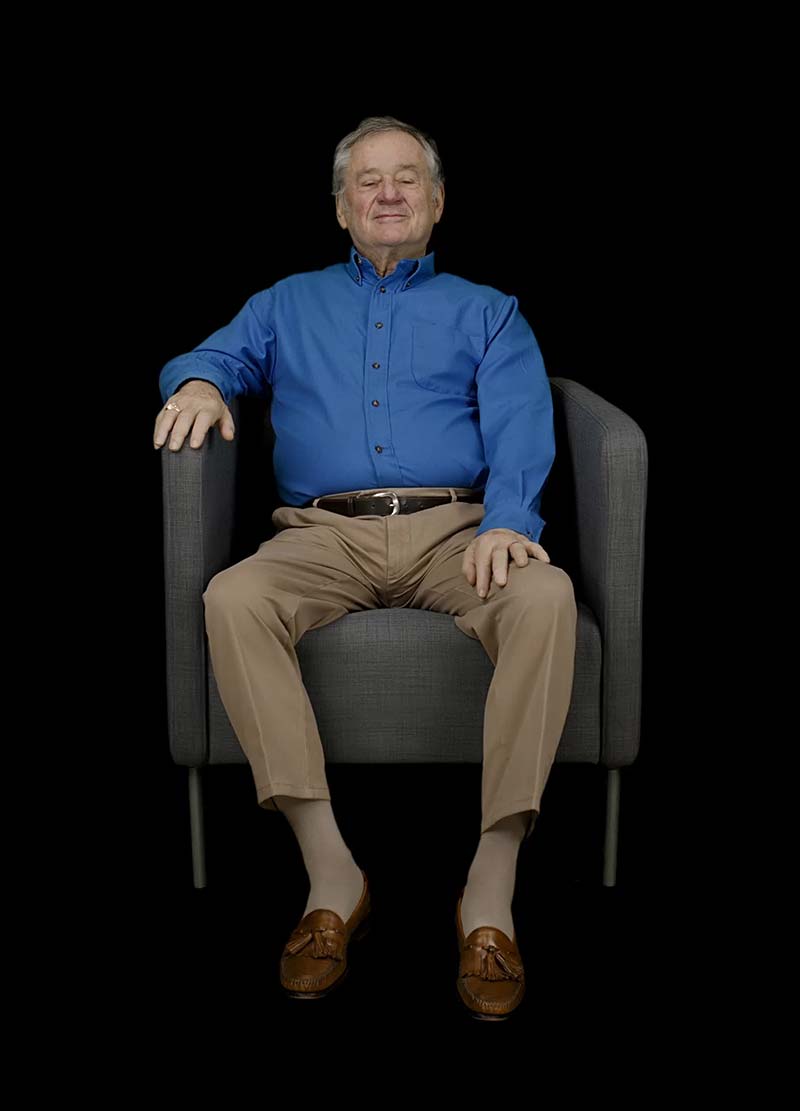
Anita Lasker-Wallfisch
Interviewed in English 2015 and in German in 2019. German interview in association with Stiftung "Erinnerung, Verantwortung und Zukunft"
Anita Lasker Wallfisch is a survivor of the Holocaust who lives in London, England. Anita was born in Breslau, Germany, in 1925. She was the youngest and had two older sisters. Her father worked as a lawyer, and her mother was a violinist. Anita picked up the cello very early on and was sent to Berlin when she was twelve to work with a cello teacher. After Hitler and the Nazis took control of Germany, life quickly changed. Anita moved back to Breslau quickly after Kristallnacht. Her mother and father were deported and she never saw them again. While working in a paper factory, Anita and her sister Renata began helping French P.O.W.’s and made a plan to escape to France using false papers. Their plan was discovered and Anita was set to prison. She served half a year of her sentence and was sent to Auschwitz. She was saved from the gas chambers when it was discovered she was a cellist; she played in the camp orchestra until November 1944 when she was transported to Belsen. She and Renata were liberated by the British Army in 1945. After liberation, she and Renata immigrated to England to reunite with their eldest sister Marianne who had managed to flee to England before the war. Anita began learning cello again and became a founding member of the English Chamber Orchestra. In 1952, she met fellow musician, Peter Wallfisch (a pianist) and they married. They had two children, a son and a daughter. Anita is still actively speaking and sharing her story today.
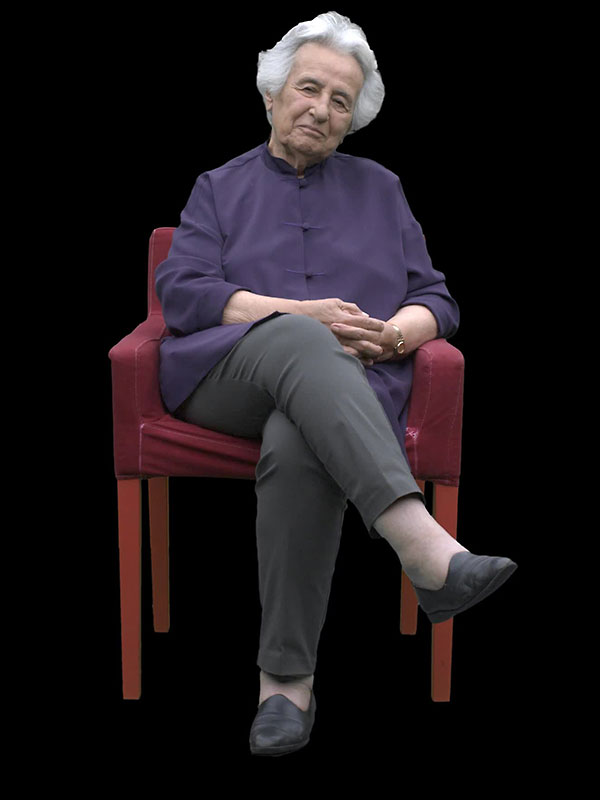
Francine Lazarus
Interviewed in English in 2021 in association with the Sydney Jewish Museum in Sydney, Australia.
Francine Lazarus is a survivor of the Holocaust who lives in the Eastern Suburbs of Sydney, Australia. Francine was born Francine Kamerman on March 12, 1938 in Ixelles, Belgium, to Israel and Marsha Kamerman. Francine is seven years younger than her brother Charles and has a half-sister, Helena, who was born after the war.
On May 10, 1940, Nazi Germany invaded Belgium. The Kamermans tried to escape into the Pyrenees, but the smuggler refused to take them with Francine's whooping cough, and the family returned to Belgium. When Francine was 4, her father hid her with a family of farmers. When the Gestapo caught the farmers, Francine was returned to Brussels. In Brussels, Francine was in near-constant movement between safe houses. Supplies such as clothes and food were scarce, shared between her and other hidden children. In July 1944, Francine’s father was sent on the last convoy from Belgium to Auschwitz-Birkenau and murdered.
After Francine’s liberation in 1945, she was put in foster care where she rebelled against her foster families and would often get thrown out. She began going to school when she was 8 years old and finished her schooling before she turned 14. In 1948, Francine’s mother remarried and gave birth to Helena. Only 11 years old, Francine was often the primary caretaker for her half-sister. In 1959, Francine boarded a ship set for Sydney, Australia, where she settled down. There, she met her husband Philip, and the two have three children and five grandchildren.
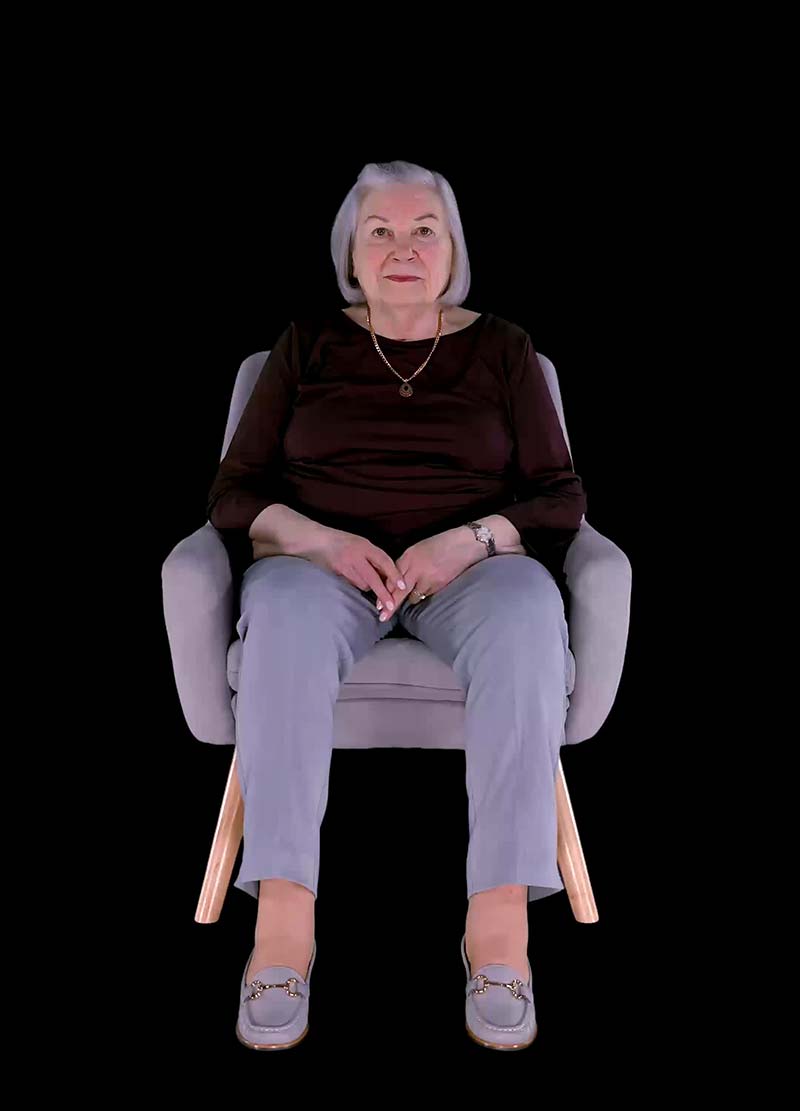
Kurt Maier
Interviewed in German in 2021 in Washington D.C. in association with the German National Library.
Kurt Salomon Maier is a survivor of the Holocaust who lives in Washington DC. Kurt was born on May 4, 1930, to Siegfried and Charlotte Maier. He and his younger brother Heinz were born and raised in Kippenheim, Germany, a small farming village on the edge of the Black Forest Mountains. Kurt’s father was a cloth peddler, his mother ran a small grocery store out of their home, and his grandparents worked with cattle.
After the Nazis came to power in Germany in 1933, anti-Jewish policies were implemented through both legal channels and organized terror. Kurt remembers Kristallnacht, when a mob threw stones at his family’s windows and ransacked the village Synagogue. Soon after, Kurt’s father and grandfather were arrested and sent to labor in Dachau. Kurt and Heinz lived with a surrogate Jewish family in Freiburg during the week to continue their schooling.
On October 22, 1940, Kurt and his family were deported to the Gurs internment camp in southern France. Conditions at the camp were poor, and Kurt’s grandfather soon passed. The rest of the family survived until a miraculous coming together of events secured the Maiers’ immigration to the United States.
On August 9, 1941, Kurt and his family arrived in New York City. Kurt proceeded to serve in the US Army, study German literature and history at Columbia University and at the Free University of Berlin, teach German, and work as a librarian. To this day, he works at the Library of Congress as a cataloguer of German books.
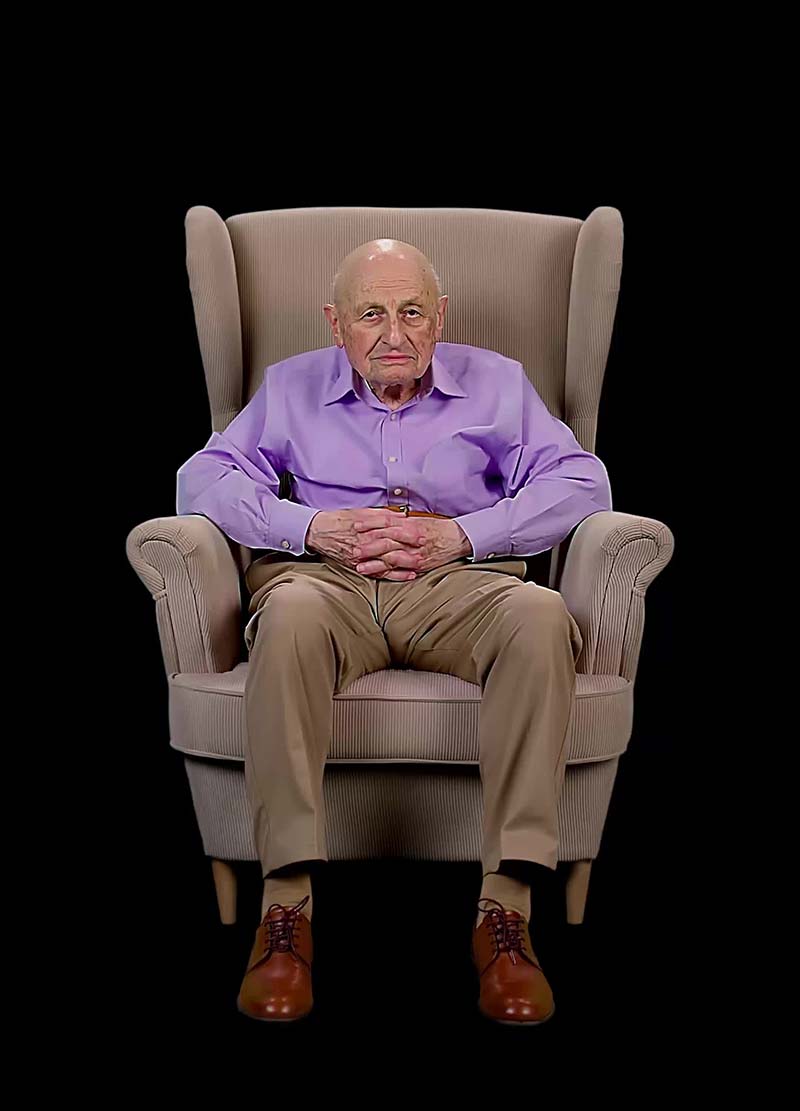
Edith Maniker
Interviewed in English in 2021 in Los Angeles, California.
Edith Maniker is a survivor of the Holocaust who lives in West Bloomfield, Michigan. Edith was born Edith Grünbaum in Leipzig, Germany on March 12, 1931. She and her sister, Paula, were born to an Orthodox Jewish couple, Abraham and Trude. Abraham was a typesetter, a printer, and a translator in the community for those needing services in Hebrew and German.
Despite Edith’s enrollment in a Jewish school, she kept her Jewish identity relatively hidden in her interactions with the larger community. She does not remember feeling any overt antisemitism until Kristallnacht, when the family watched their synagogue burn from the windows of their apartment. In the aftermath of Kristallnacht, Edith’s father lost his job and multiple family members who had lost their home moved in with them.
Thanks to Edith’s uncle, who held an important role within the Jewish community in Leipzig, the Grünbaums could procure places for Edith and Paula on a Kindertransport to England. Relatives in England were able to sponsor both girls and four of their cousins. Edith left for England in July 1939, one month after her sister. Both were able to survive the Holocaust, including the bombings of England. However, their parents, grandparents and numerous other relatives all perished.
In 1947, Edith and her sister moved to the United States and settled in Detroit, Michigan alongside extended family members. Edith met and married Aaron Maniker and spent her life working with emotionally impaired children. She has three children, four grandchildren, and one great-grandchild.
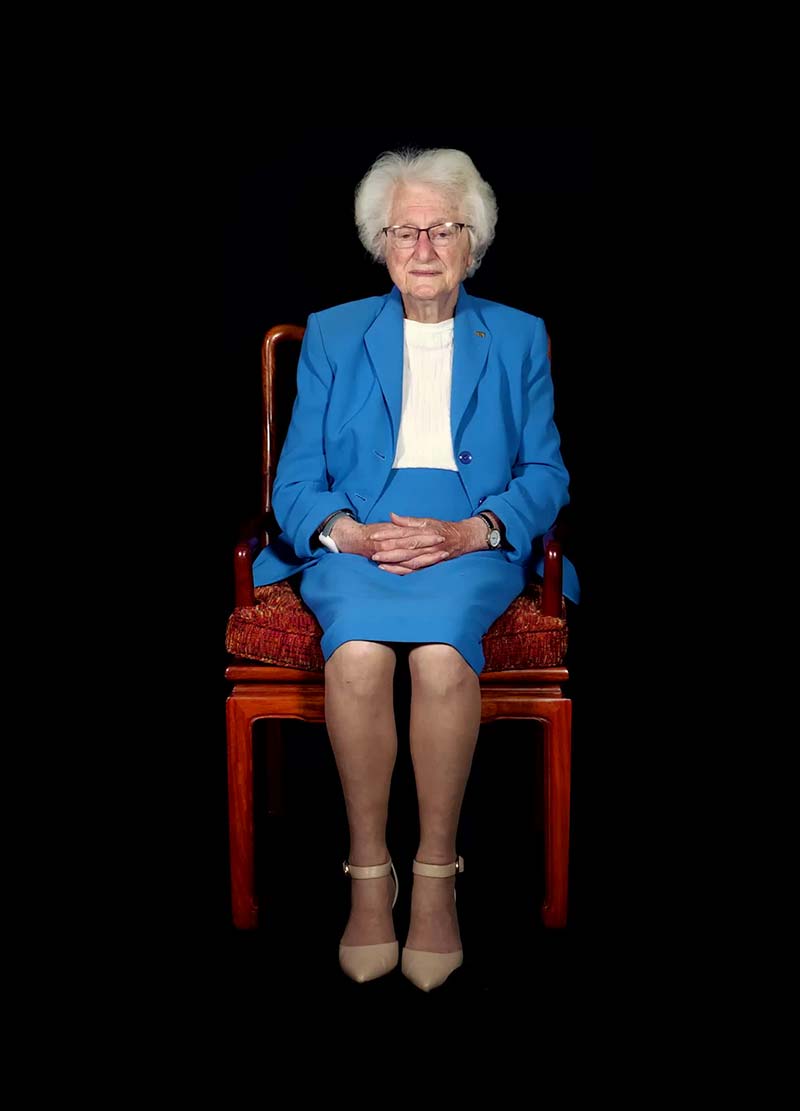
Kurt Marx
Interviewed in English in 2024 in London, UK in association with the USCSF Willesden Lane Project.
Kurt Marx is a survivor of the Holocaust who lives in London, England. Kurt was born on August 31, 1925 in Cologne, Germany to Irma and Siegmund Marx. Kurt celebrated his Bar Mitzvah in a synagogue that burned down during Kristallnacht a mere two months later. Thanks to Kurt’s school principal, Kurt and thirty-nine other students were evacuated from Germany through the Kindertransport.
Kurt arrived at London, England, on January 18, 1939. He stayed in London until the start of the war, when he was evacuated to the town of Bedford, where the Allan family housed him for two years. At age 17, Kurt moved back to London to work as a diamond polisher. It was at the start of this time that Kurt received his last letter from his parents, who were deported to Minsk and murdered in Maly Trostenets. In 1944, at age 18, Kurt was conscripted to the National Service until the war’s end in 1945.
After the war, Kurt remained in London. He met his future wife, Ingrid, and married her in 1948. The two relocated to Accra, Tanzania, as part of Kurt’s career in the diamond industry. Their son, Michael, was born in 1961, after which the family moved back to London. Nowadays, Kurt speaks about the importance of Holocaust education, fighting against the rise of prejudice, and speaking of lesser-known parts of the Holocaust such as Maly Trostenets.

Al Miller
Interviewed in English in 2022 in association with The Nancy and David Wolf Holocaust & Humanity Center in Cincinnati, Ohio.
Al Miller was a survivor of the Holocaust who lived in Hamilton, Ohio. Al was born Albert Werner Mueller (Müller) on November 20, 1922 to parents Alfred and Charlotte. The family lived in Berlin, Germany, and ran a successful shirt and pajama factory named Mueller & Sussman. Al remembered a happy childhood. He was sent to a progressive school that promoted athletics. In 1936, he went to the Berlin Olympics and saw Jesse Owens win a gold medal.
Al recalls the changing attitudes of Berliners around his family. In 1937, Al’s grandfather arranged for him and his brother, Bruno, to leave Germany. Al attended school in Switzerland while Bruno worked in England. After Kristallnacht, Al’s parents fled from Germany to Belgium. Al joined them in Belgium, and the trio traveled to meet Bruno in London. Amidst their fraught status as German “enemy aliens,” Al’s father secured American visas for the family. The four immigrated to the United States in August, 1940 and settled in Cincinnati.
In April 1943, Al was inducted into the U.S. Army. He trained as a medic, and then as a Ritchie Boy: an interrogator. Al served abroad until his discharge in 1946. He returned to the US, where he studied optometry and met his wife, Jane. The two married in 1951 and had three sons. Al was an active member of his community - playing sports, acting in the local theater, serving as synagogue president, and speaking about his experiences - up until his passing in August 2023.

William Morgan
Interviewed in English in 2017 in association with Holocaust Museum Houston
William Morgan is a survivor of the Holocaust who lives in Houston, Texas. William was born Wolf ‘Yossela’ Marguiles in Czerniejow, Poland in 1925. He and his six other siblings were raised in poverty and practiced Orthodox Judaism. In 1939, the Russians began to occupy his hometown. In 1941, the Hungarian army marched into Czerniejow and severe persecution of the Jews began. William’s grandfather was drowned in the river by the Hungarians and the rest of the family was sent to live in a ghetto in Stanislawow. While in the ghetto, William was able to work as a farmhand outside of the ghetto and he was able to move in and out for three months. After being forced to dig a mass grave for Jews from the ghetto who were subsequently executed, he made plans to escape the ghetto. He left his parents and siblings in the ghetto after obtaining a Polish Christian birth certificate. He fled to Jezierzany, Ukraine and worked as a farmhand for four years, concealing his Jewish identity. He was drafted into the Polish branch of the Soviet Army in 1944, and was sent to Katowice, Poland. He deserted the army and in 1945 began working as a civilian driver on the black market. He moved to a DP camp in Frankfurt, Germany where he waited for his visa to move to the United States. He immigrated to the U.S. in 1949, first to Cedar Rapids, Iowa where he worked in a shoe store. He moved to Houston, Texas in 1950. In 1954, he married a local woman, Shirley, and they had five children. He eventually created a thriving real-estate business that still operates today. He is one of the founders of the Houston Holocaust Museum.

Ed Mosberg
Interviewed in English in 2018
Ed Mosberg was a survivor of the Holocaust living in Morris Plains, New Jersey, at time we recorded him for Dimensions in Testimony. Ed was born to a non-religious family in 1926. He, along with his two sisters, grew up in Krakow, Poland. In 1939, the Nazis invaded Poland and the war began. Ed and his father fled to a smaller town outside Krakow because men were being forced into hard labor. His father was rounded up and killed at a police station. Ed went back to Krakow and he along with his mother and two sisters were forced into the ghetto. In 1943, the Krakow ghetto was liquidated and the Mosberg family was sent to Plaszow, a labor camp. The labor camp was run by Amon Goeth, whom Ed met and worked under. In 1944, Ed’s mother was sent to Auschwitz and his sisters were sent to Stutthof. Both his mother and sisters are killed in the camps they are sent. He was deported to Mauthausen and is eventually sent to Linz. He was liberated from Linz in 1945. After the war, he reunited with Cecile, a girl he had met in Plaszow, and she along with Ed and her father moved to Belgium. Cecile and Ed married in 1947 and they have their first daughter in 1950. Ed, Cecile, and their daughter received visas to immigrate to the United States in 1951 where they first settled in New York. Ed eventually broke into the construction business and he and his family moved to Morris Plains. Ed passed away in 2022.

Alan Moskin
Interviewed in English in 2019
Alan Moskin was a veteran of World War II and liberator of the Gunskirchen Concentration Camp who lived in Rockland County, New York. Alan Robert Moskin was born in 1926 in Englewood, New Jersey. His father was a pharmacist, served as elected city official, and eventually became one of the few Jewish mayors in New Jersey. When Alan was 16, the Japanese bombed Pearl Harbor, and America entered the war. In October 1944, Moskin was drafted in the US army and after completing his basic training Alan was deployed to England as a Private First Class in Patton’s Third Army, 66th Infantry, 71st Division. Alan fought on the front line across France through the Rhineland and into Austria. In May of 1945, Alan’s unit liberated a prisoners of war camp in Lambach, Austria and then they liberated the Gunskirchen Concentration Camp, a sub-camp of the Mauthausen concentration camp, where Alan and his fellow soldiers learned for the first time about Nazi mass murders of Jews and were shocked with suffering of the prisoners. Alan met the Victory Day in Europe in Wels, Austria. Until he was honorably discharged in June 1946, Moskin served in the army of occupation in Austria. He attended the Nuremberg Trials during this time. After the war, Alan returned to his studies in Syracuse University and then to New York University where he obtained his JD in 1951. Together with his ex-wife Krista, he has two daughters. After Alan has retired from his career in trial law and civil litigation, he spent his time volunteering with Jewish war veterans, speaking to students, working with local Holocaust museums, and as a volunteer color guard at naturalization ceremonies. Alan passed away in 2023.
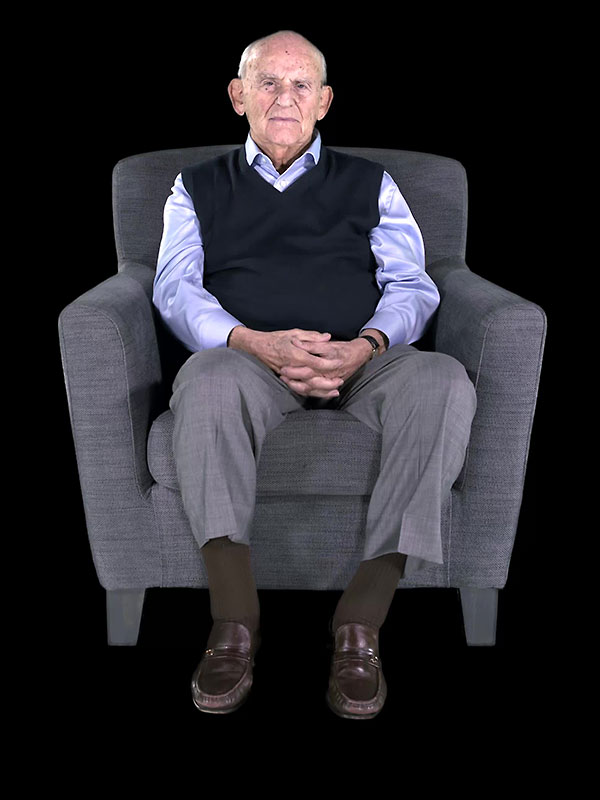
Khatchig Mouradian
Interviewed in English in 2024 in Los Angeles, California.
Dr. Khatchig Mouradian is a descendent of Armenian genocide survivors. He was born in Beirut, Lebanon in 1977 during the Lebanese Civil war. His grandparents were child survivors of the Armenian Genocide. In 2007, Dr. Mouradian moved to the US where he completed his master and PhD degree. Today, he is a lecturer at Columbia University, and also serves as the Armenian and Georgian specialist at the Library of Congress. He is a historian by profession, and one of his research topics is the Armenian Genocide and its legacies.

Lea Novera
Interviewed in Spanish in 2018
Lea Novera is a survivor of the Holocaust who now lives in Buenos Aires, Argentina. Lea Novera was born Liza Zajac in 1926 in Hajnowka, Poland to parents Ester and Aaron Zajac. She and her two siblings grew up in a lower middle class family and Lea attended Polish school. When the war began, they lived first under first Soviet and later Nazi occupation. In 1942, the family was forced to move to Pruzany ghetto and in 1943, they were deported to the Auschwitz camp complex. Upon arrival, Lea’s parents and siblings were murdered in the gas chambers. Her mother saved her by shouting to her to go with the “stronger looking” group and her aunt Sara; Lea lied about her age and became a slave laborer. After being struck in the knee, she developed tuberculosis and was infirmed in the camp hospital. There, she befriended a doctor who saved her from selections and helped to her survive. She was saved again when a secretary erased her name from a death order signed by Dr. Mengele. Lea eventually joined a cell of women who planned multiple acts of sabotage around the camp, including the dynamiting of the crematorium. She was sent on a death march with Sara in January 1945 and was liberated by Soviet Forces in April. Lea immigrated illegally to Argentina and married Holocaust survivor and partisan, Marcos Novera. They had two sons. She is an early member of the Holocaust Museum in Buenos Aires and the group Generations of the Shoah and wrote the memoir Historias de Mi Mochila.
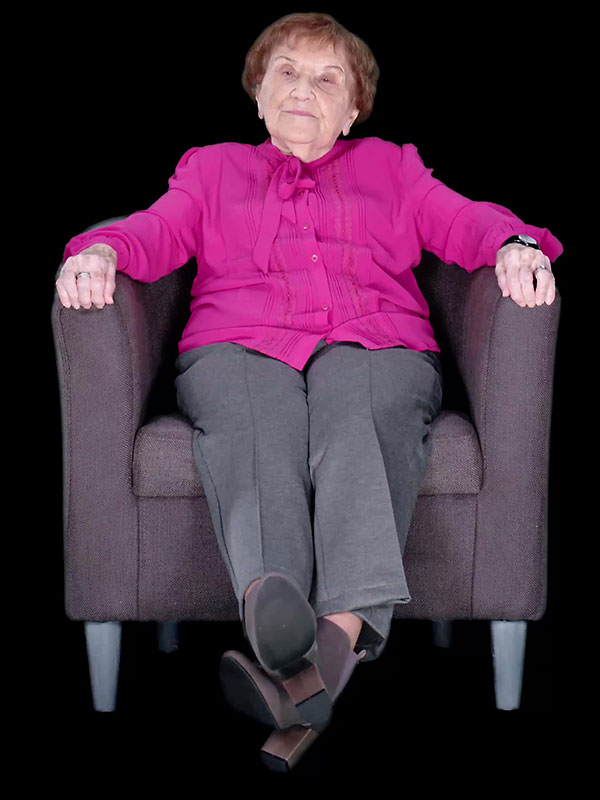
Janine Oberrotman
Interviewed in English in 2016 in association with Illinois Holocaust Museum and Education Center
Janine Oberrotman was born Janina Binder in 1925 in Lvov, Poland. She was an only child and her father owned a successful shipping business. For the most part, Janine was raised by her mother, who was extremely protective of her only child. A love for the written word permeated the home, as well as a love for music. The family was not very religious, and Janine had many gentile friends. An excellent student, Janine gained entry to a prestigious state high school, despite limitations on enrollment for Jewish students.
In 1941, Janine was recovering from a serious bout of Scarlet Fever when the German Army entered Lvov, following the Soviet retreat. Soon after, the Lvov ghetto was created, and Janine’s family was forced to give up their home and move there. Janine’s grandfather was taken and killed along with other elderly Jews. Janine’s father was captured while carrying a bag of potatoes to feed his family, and then deported to Janowska Concentration Camp, where he was later killed. Janine and her mother fled from hiding place to hiding place, narrowly evading capture numerous times. With her mother’s help, Janine managed to escape the ghetto and find her Aunt Wanda, who was living in another part of Lvov under an assumed identity. Using papers she obtained from a gentile friend, Janine was able to travel to a Ukrainian village where her maternal uncle and grandmother were hiding as Catholics. There, Janine learned of her mother’s death during the liquidation of the Lvov ghetto, and the subsequent suicide of her Aunt Wanda, who feared that under torture she might give up the whereabouts of her family. In 1943/44 Janine was arrested and transported back to Lvov on suspicion of being Jewish. Lacking evidence about her origins, the Gestapo sent her to Stuttgart to work as a Polish forced laborer. Janine survived the rest of the war working in a restaurant as a non-Jewish Pole. She was liberated by the French Army in spring 1945.
After the war, Janine moved to Paris, and in 1946 was interviewed for the first time by American psychologist David Boder. In 1950 Janine married Joseph Oberrotman, a survivor of the Warsaw Ghetto. The couple had their first son in Paris. In 1953 the new family moved to the US and settled in Chicago, where they had two more sons. In Chicago, Janine worked as a French teacher and a vocational counselor for refugees arriving in the US. She also shared her experiences with thousands of students, teachers, law enforcement personnel, and others, inspiring them with her story of courage, resilience, hope and survival.

Susan Pollack
Interviewed in English in 2021 in association with the Holocaust Educational Trust in London, UK.
Susan Pollack is a survivor of the Holocaust who lives in London, England. Susan was born Zsuzsanna Blau in 1930 in the village of Felsögöd, Hungary. She lived with her two parents and her brother, Laci. Susan recalls a secure, sheltered life before the escalation of antisemitism. In 1938, her uncle was murdered by his Fascist neighbor, who was barely punished for the act.
Antisemitism worsened when the war broke out in 1939, and again when the Nazis invaded Hungary in March of 1944. Susan’s father was called to a meeting, arrested, and taken to a concentration camp, never to be seen again. In May of 1944, Susan, Laci, and their mother were transported to the Vác ghetto, then taken to a prison camp and finally to Auschwitz-Birkenau. Laci was separated from the women, Susan was selected to work, and their mother was sent to the gas chambers. Susan survived Auschwitz, the Guben armament factory, a death march, and the Bergen-Belsen concentration camp. She was liberated by the British Army on April 15, 1945.
After liberation, Susan discovered that over 50 of her relatives were killed. Luci, her brother, had survived, but was suffering mental health problems caused by the work he was forced to undertake in Auschwitz. Susan lived in Sweden and Canada, where she met and married a fellow survivor, Abraham. The couple had three children and six grandchildren. Today, Susan lives in London and has made it her mission to share her testimony with anyone who will listen.

Marguerite Quddus
Interviewed in French in 2021 in Montreal, Canada in association with the Montreal Holocaust Museum and the Canadian Museum for Human Rights.
Marguerite Quddus is a survivor of the Holocaust who lives in Montreal, Canada. Marguerite was born as Marguerite Élias on December 4, 1936 in Paris, France. Her parents, Maurice and Rachel, were Lithuanian immigrants who owned and worked a Parisian furrier shop. Marguerite had one older sister named Arriete.
When the war broke out in 1939, Marguerite’s father signed up to volunteer for the French Army. He was mobilized until August 1940. When Germany occupied France that summer, restrictions began accumulating for Jews. The Élias’s personal lives were regulated and minimized, and their business was taken over and closed. On August 20, 1941, Marguerite’s father was arrested during a round-up. She never saw him again. Marguerite’s mother had been arrested in July of 1942, but managed to get released. She hid Marguerite and Arriete and arranged fake baptism certificates for them. The sisters were moved from hiding spot to hiding spot as their mom participated in resistance efforts in Lyon until they could reunite in the spring of 1945.
After the war, the three returned to Paris where they faced housing and economic tribulations. In 1946, Marguerite’s mother remarried and gave birth to her half-brother, Benoît. In 1962, Marguerite met her future husband Abdul Quddus, a Bengali engineer. They two married in 1965 and immigrated to Canada in 1967, where they had their son, Michael. Since then, Marguerite has shared her story with thousands of students, and published her memoir “In Hiding,” which she illustrated with her paintings.

Tobias Rawet
Interviewed in Swedish in 2020 in association with the Swedish History Museum in Stockholm, Sweden.
Tobias Rawet is a survivor of the Holocaust who lives in Sweden. Tobias was born Tolek Rawet on February 12th, 1936 in Lodz, Poland, to Estere and Solomon Rawet. The family lived off of Lodz’s main thoroughfare, where they operated a small kosher delicatessen.
Tobias remembers his parents pulling him on a toboggan towards the Lodz ghetto in February of 1940. They were assigned to live in an apartment along with Tobias’s grandmother and two uncles. When Tobias was 6 years old, the ghetto was ordered to deport all children under the age of 10. Tobias’s parents hid him until they could procure a fake ID. Documented as 10 years old, Tobias stayed with his family and worked in the ghetto for rations.
In October of 1944, Tobias and his parents were deported to Ravensbrück, where his father was separated from them. Four months later, Tobias and his mother were sent to the Königs-Wusterhausen labor camp in Germany, where they survived until being liberated by the Soviet Army in April, 1945. After liberation, Tobias’s mother found his father in a nearby men’s camp, reuniting the three before returning to Lodz.
The rise of antisemitism in postwar Poland caused Tobias’s family to flee to Sweden in 1948. Tobias finished school, studied communications, and worked as an engineer. He married his wife, Monica, in 1961. Tobias and Monica have three children and nine grandchildren. Since 1966, after retiring from engineering, Tobias has spoken about his experiences in defiance of rising Holocaust denial.
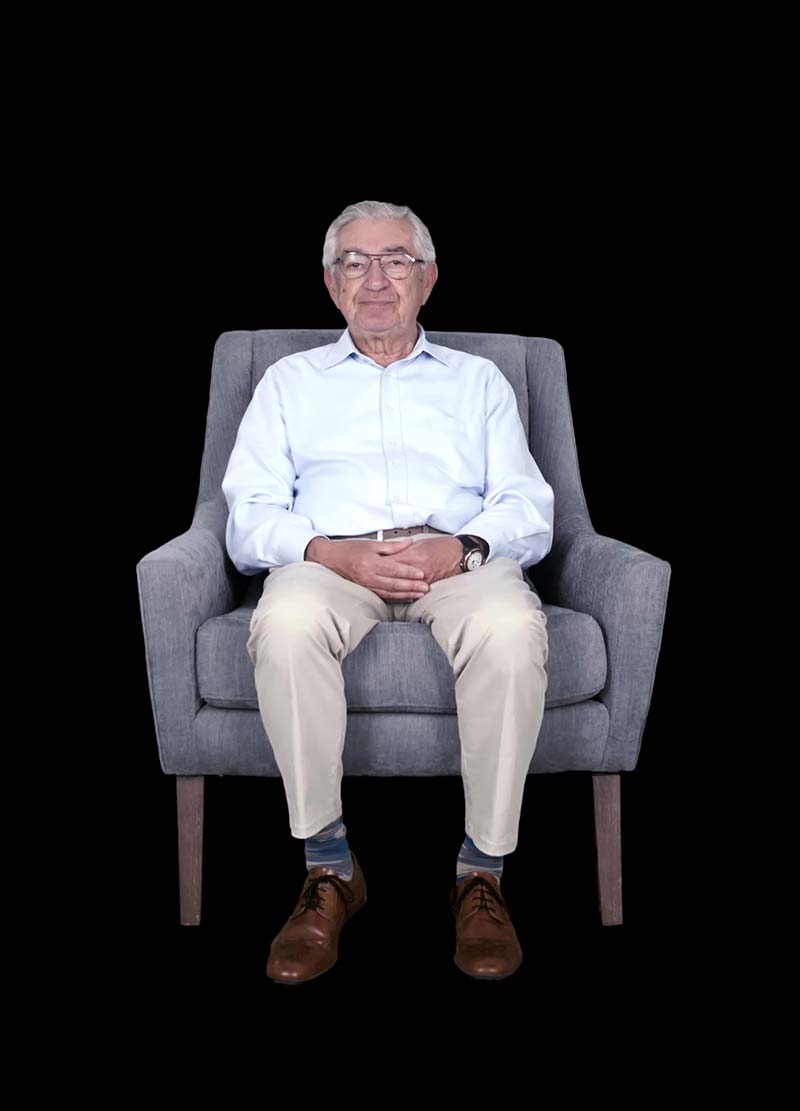
Leonid Rozenberg
Interviewed in Russian in 2019 in association with Genesis Philanthropy Group
Leonid Borisovich Rozenberg was born in September 1921 in Iziaslav, Ukraine. Later, his family moved from Kamenets-Podol’sk to Zhitomir oblast. His father participated in the Russian Civil War on the Bol’shevik side and later worked at a factory and his mother worked as a teacher and then as a pharmacist. On June 6, 1941, Leonid graduated from an artillery school and was sent to the city of Lida near the border with Germany occupied Poland where he met the first day of the Great Patriotic War. His father was drafted to the Soviet army in 1939 and his mother with his younger brother and sister stayed in Zhitomir oblast where they were killed by Germans in September 1941. During the first days of the war, he was wounded and encircled by German forces, but was able to reach a Soviet military unit. After about a month at a hospital, Leonid Borisovich returned to the army and participated in the battle of Caucasus in 1942-1943, battle of Kursk, battle of Dnieper, Vistula-Oder Offensive, and Berlin Offensive. He met the Victory Day in Berlin. For his service, Mr. Rozenberg was awarded with several awards, including the order of the Red Banner. After the war, Leonid Borisovich stayed in Germany within the Group of Soviet Occupation Forces. In the late 1950s, he graduated from the Frunze Military Academy and served in the Soviet Army until his retirement. In 1991, he immigrated to the USA and has been serving as the President of the American Association of Veterans & Invalids of WWII.
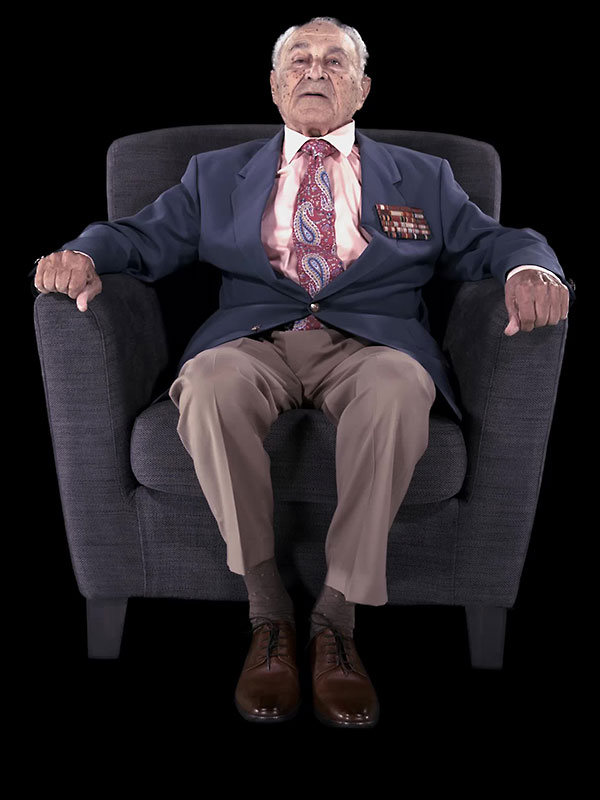
Sara Rus
Interviewed in Spanish in 2019 in association with the Museo del Holocausto in Buenos Aires, Argentina.
Sara Rus was a survivor of the Holocaust who lived in Argentina. She was born in Lodz, Poland in 1927 as Sheine Miriam Laskier to her parents, Carola and Jacov Laskier. Sara was 12 when World War II started and, a year later, she and her family were forced into the Lodz ghetto. Her newly born brother, David, did not survive the inhumane conditions. In 1944, the Laskiers were deported to the Auschwitz II-Birkenau camp. Sara and her mother were transferred to work in an airplane factory in Freiberg, Germany, where she suffered severe occupational injuries.
Sara was liberated from the Mauthausen camp in 1945 by American forces. During her long recovery in the liberated camp, she reconnected with her future husband Bernardo Rus, whom she initially met in the Lodz ghetto. The two married, but had to flee Poland due to the heavy antisemitism of their peers. The couple fled to Berlin, Germany. While living in a refugee camp, Sara was discovered as an actor and joined a newly formed theater company. In 1948, Sara reconnected with an uncle in Argentina and made the decision to move. Sara and Bernardo immigrated illegally, but were granted clemency when their story was explained. The couple had 2 children, Daniel, who was vanished by Argentina’s dictatorship in 1977, and Natalia, mother of their 2 granddaughters: Paula and Alejandra. Sara kept telling her story until her passing, at age 96, in January of 2024.

David Schaecter
Interviewed in English in 2023 in association with the Holocaust Legacy Foundation in Miami, Florida.
David Schaecter was a survivor of the Holocaust who lived in Miami, Florida. David was born on August 29, 1929 near the village of Snina in Czechoslovakia, province of Slovakia. He grew up on his family’s farm, playing outdoors, learning to take care of crops and animals, and skiing in the winters.
David recalls when his childhood ended. It was in April of 1942. David, his mother Serena, his older brother Jakovo, and his two younger sisters Leah and Miriam were all deported to Auschwitz. David’s father, Isidore, had already been conscripted to a Slovak labor battalion a year or two earlier. Upon arrival at Auschwitz, David’s mother and sisters were sent to gas chambers and killed. David and his brother remained in Auschwitz until the end of the summer in 1943, when they were transferred to Buchenwald. Jakovo died in the summer of 1944, leaving David devastated. In November 1944, David was transferred to the Regensburg concentration camp. The train was bombed on its route, and David escaped near the Czechoslovakian border. He joined a group of Czech resistance fighters and stayed with them until the end of the war.
In 1949, David left Czechoslovakia. He arrived in the USA at the start of 1950 and studied industrial engineering in Los Angeles. David met his first wife, Marvis, while traveling for his work. The couple settled in Miami and raised two children. After Marvis passed, David found another love in his second wife, Sydney. He was a loving father, step-father, grandfather, and great-grandfather. David passed away in 2025.

Eva Schloss
Interviewed in English in 2015
Eva Schloss is a survivor of the Holocaust who lives in London, England. Eva was born Eva Geiringer in Vienna, Austria, in 1929 to Erich and Fritzi Geiringer. Eva had an older brother named Heinz with whom she was very close. They were an upper-middle-class, nonreligious family, who made their living thanks to a shoe factory that Erich owned. In 1938, Germany annexed Austria in an event known as the Anschluss. Laws against Jews were immediately enacted and the family made plans to flee to the Netherlands. Eva’s father was able to move to Amsterdam in 1939 and the rest of the family joined in 1940. The Geiringers met the Frank family during their time in Amsterdam; as young girls, Eva and Anne were neighbors. In 1942, after the Nazis occupied the Netherlands, Eva and her family went into hiding. On Eva’s 15th birthday in 1944, the family was betrayed and sent first to Westerbork Concentration Camp and then to Auschwitz II-Birkenau. Eva’s father and brother died after they were sent on a death march to the Mauthausen concentration camp. Eva and her mother spent the war together in Birkeanu and were liberated by the Soviet Army in 1945. After the war, they moved back to Amsterdam and reconnected with Otto Frank. Eva moved to London and married Zvi Schloss. Eva’s mother Fritzie and Otto Frank later married as well, making Eva Anne Frank’s posthumous stepsister. Eva and Zvi would go on to have three daughters and five grandchildren. Eva is a cofounder of the Anne Frank Trust UK and is still very active today sharing her story without groups all over the world.
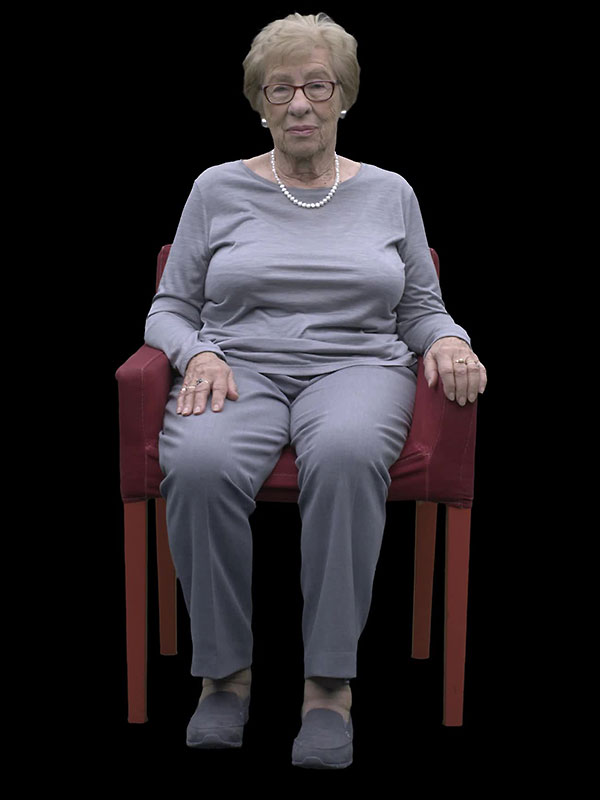
Adina Sella
Interviewed in English in 2016 in association with Illinois Holocaust Museum and Education Center
Adina Sella is a child survivor of the Holocaust who currently lives in Chicago, Illinois. Adina was born Peggy Schaufeld in Hamburg, Germany in 1935. In 1939, her father was arrested in Germany for having Polish origins and was only released when Adina’s mother secured visas to move the family to Italy. They had planned on going to to Shanghai from Italy but while en route were marooned in Italy due to the war. They settled first in Arezzo where they posed as Catholics. In Arezzo, Adina and her brother attended a school at a convent, where the nuns treated them kindly and protected their Jewish identity. When the nuns and priests learned that the Germans were advancing toward Arezzo, they warned the Schaufelds who fled with the assistance of the the Italian underground to transfer to Anghiari. The Marconi family hid Adina and her family and they were liberated in the spring of 1944 in the town of Verazzano. In 1945, the Schaufeld family moved to then-Palestine where Adina attended school until she joined the Israeli army. In 1956, she left Israel to study psychology in Switzerland where she met her husband Michael Sella. In 1963, Adina and Michael moved to Chicago, Illinois where they operated a medical center together. Adina and Michael had one daughter.

Asia Shindelman
Interviewed in Russian in 2019 in association with Genesis Philanthropy Group
Asia Shindelman is a survivor of the Holocaust who now lives in Wayne, New Jersey. Asia Shindelman was born Asia Levin in 1928 in Siauliai, Lithuania. Her father was a hairdresser and owned a hair salon. Asia had an older brother Zev. The family observed Jewish religious traditions and Asia studied at a Hebrew school. After Lithuania was annexed by the USSR in June 1940, the Soviet authorities seized Asia’s father business and Asia could continue her education only in Yiddish. On June 25, 1941, three days after Germany invaded the Soviet Union, Siauliai was occupied by German troops who introduced anti-Jewish measures and organized anti-Jewish roundups and arrests. Asia’s family lost track of her brother, who was at the time in Kaunas, and lately they realized that he was killed during the first days of the Nazi occupation. In August 1941, Asia was forced into the ghetto with her parents, uncle, and grandmother. In July 1944, Asia and her family were deported to Stutthof concentration camp. In Stutthof, she and her mother were separated from her father and uncle, who were transferred to Dachau concentration camp. Asia’s grandmother was immediately killed in a gas chamber. In a few weeks, Asia and her mother were transferred to Malken concentration camp and then to Dörbek, another Stutthof subcamp. Asia worked as a slave laborer in the camps, building military fortifications, until January 1945 when prisoners were sent on a death march. On March 10, 1945, Asia and her mother were liberated by the Soviet army near the village of Chinow in Pomerania, then Germany, now Poland. Three months later, they reunited with Asia’s father and together returned to Siauliai. In 1950, her father was sentenced to ten years of imprisonment allegedly for “anti-Soviet activities”, but was released in 1955. She married Yudel Shindelman in 1950 and they have two sons. Asia graduated from Riga University and worked as a chemical engineer in Riga, Latvia. Asia and her family immigrated to the USA in 1991. Asia regularly shares her story with schoolchildren and members of local community. In 2019, Asia was invited to witness in the trial of a former Stutthof camp guard.
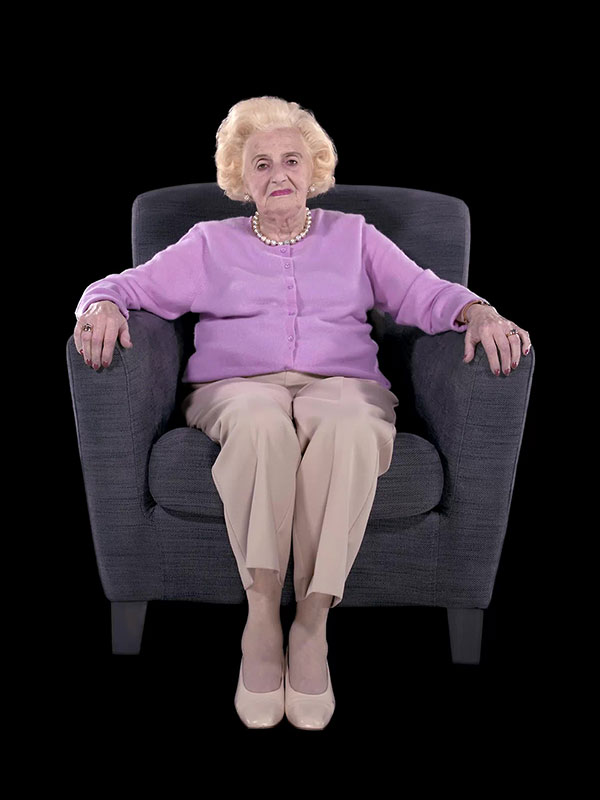
Stella Sonnenschein
Interviewed in English in 2022 in association with the Holocaust Documentation and Education Center in Dana Beach, Florida.
Stella Sonnenschein is a survivor of the Holocaust who lives in Aventura, Florida. Stella was born Esther Berenstein on August 11, 1935 in Warsaw, Poland. Her parents, Hersch and Stefanie Berenstein ran their own business each. In 1940, a year after the war started, Stella, her parents, and her older brother Yosek, were forced to live in the Warsaw ghetto.
In 1942, Stella’s parents had her smuggled out of the ghetto. She was given a new identity as a Polish-Catholic orphan, and taken in by foster families. Over the next three years, Stella lived under her false identity with four different Polish families who helped her survive. When the war ended in 1945, Stella believed that she was the only Jewish person left alive. In 1946, Stella’s mother found her and the two reunited. Though Stella’s mother had survived, Stella learned that her father was killed during a rebellion, and her brother had been taken by Gestapo police and killed in prison.
In 1950, Stella and her mother left Poland for Israel, where they had surviving relatives. There, Stella met and married her husband, a fellow survivor named Ben. The couple immigrated to the US in 1958, settled in New Jersey, and raised two children. They later moved to Aventura, Florida, where Stella resides today. She loves to spend her time with friends and family, dressing in bright colors, and living a life filled with gratitude.

Israel ("Izzy") Starck
Interviewed in English in 2016 in association with Illinois Holocaust Museum and Education Center
Israel ‘Izzy’ Starck is a survivor of the Holocaust who lives in Chicago, Illinois. Izzy was born Israel Storch in 1929 in Podhorany, Czechoslovakia. He and his three sisters were raised in an orthodox household. After the Germans invaded his hometown in spring 1944, the Storch family was taken to the Munkacs ghetto and deported to Auschwitz II-Birkenau where Izzy was separated from his sisters and mother. He later learned his mother was gassed upon arrival. Izzy lied about his age during the selection and entered the camp with his father. Izzy and his father were then sent to Mauthausen where they were separated and his father died in Gusen. Izzy was then sent from Mauthausen to Melk, where he dug tunnels for the German air force. In early 1945, Melk was evacuated and he was sent to Ebensee where he was liberated from by the Americans on May 8, 1945. After the war, the American Army took Izzy back to his hometown of Podhorany, where he found that his two older sisters had survived the war. In 1948, Izzy and his sisters immigrated to the United States and he settled in Chicago. He started his own diamond cutting company. In 1957, he married Ethel and they had seven children. He and his family remained Orthodox.
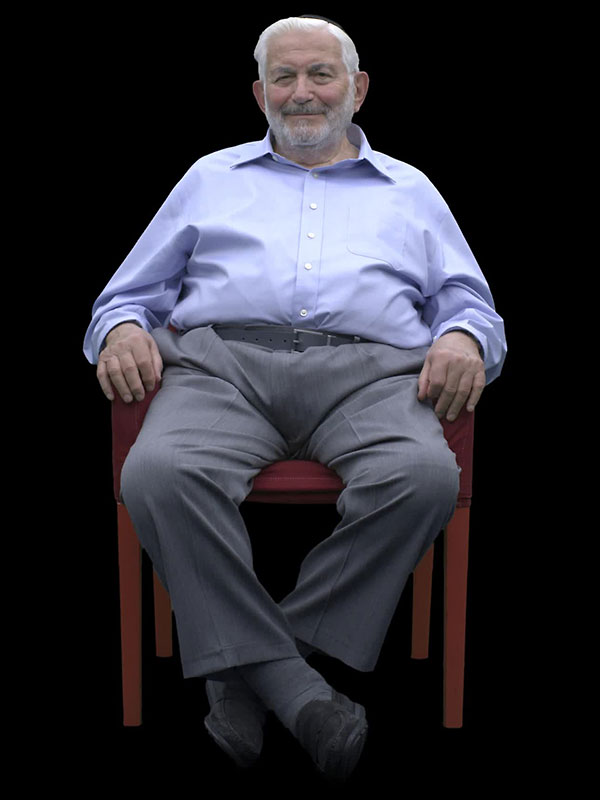
Matus Stolov
Interviewed in English in 2016 in association with Illinois Holocaust Museum and Education Center
Matus Stolov was a survivor of the Holocaust who lived in Chicago, Illinois. Matus was born in 1928 in Minsk, Belorussia. He had one older brother, Boris. In 1936, Matus’ father died of natural causes. Under Soviet laws, all expression of Jewish life ended in 1934, so Matus received no religious education growing up. He only celebrated Soviet holidays. In 1941, Germany invaded Minsk and a ghetto was built around the Jewish section of the city. Boris was able to escape, but Matus and his mother were forced to live with another family. Routine actions took place in the ghetto were the Jews were taken out and shot in mass executions. Matus and his mother survived this by hiding with the help of a Christian friend named “Big” Yelena. In 1942, “Big” Yelena arranged for Matus and his mother to be smuggled out of the ghetto by the Partisans. In 1942, they crossed the front lines and settled in Kazan. They were liberated in June 1945 and returned to Minsk. After liberation, Matus and his mother received a notice that Boris had been killed in combat when he was serving in the Red Army. After the war, Matus finished University where he was studying to become a mechanical engineer. In 1952, he married Victoria, a woman from Minsk whom he had known since grade school. In the early 1980’s, Matus was able to immigrate to the United States after ten years of trying to leave the Soviet Union. He, Victoria, and their daughter settled in Chicago. Matus passed away in 2020.
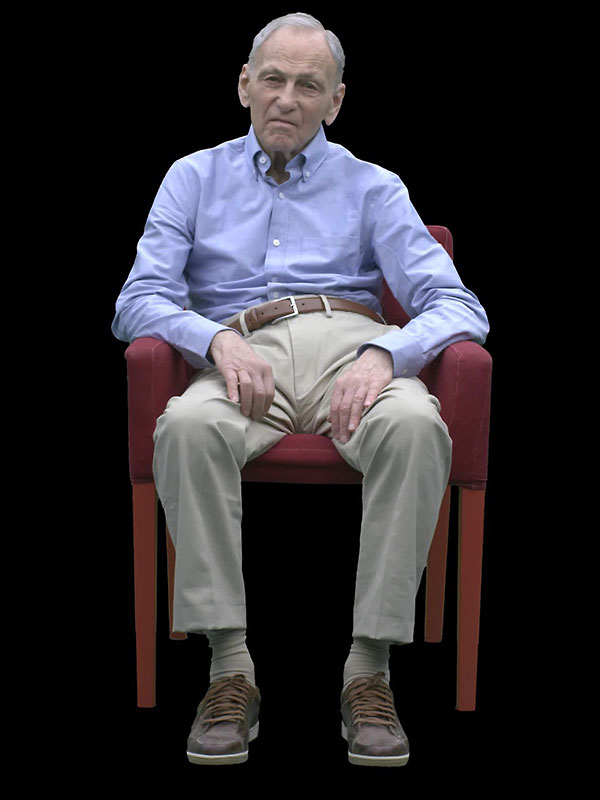
Xia Shuqin
Interviewed in Mandarin in 2016
Madame Xia is a survivor of the Nanjing Massacre who resides in Nanjing, China today. Xia Shuqin was born in Nanjing in 1929, to a family consisting of her parents, two older sisters, and two younger sisters. On December 13, 1937, the Japanese army entered the city of Nanjing, and began a series of rampage and massacre of innocent Chinese people. On that day, Madame Xia’s family faced the same fate. After the family had just eaten breakfast on December 13, Japanese soldiers broke into Madame Xia’s home and killed her parents, three of her sisters, her two grandparents, and another family of four. Madame Xia woke up to a home of a brutally murdered family, wounds on her back, and her four-year-old sister, still alive, crying for help. Madame Xia and her sister hid in the house for ten days with minimal water and food, and were finally rescued by old people living in an elderly home nearby. After a few weeks at the old people’s home, Madame Xia’s uncle, who fled Nanjing before the massacre, took Madame Xia and her sister in. Madame Xia lived with her uncle intermittently until the end of the war, and her living conditions improved significantly after the Communist Revolution and formation of the PRC in 1949. Madame Xia is one of the most active survivors of the Nanjing Massacre. After the war, she travelled multiple times to Japan to speak with scholars and sue right-wing members that denied the Massacre. She also spoke regularly at the Nanjing Massacre Memorial Hall in Nanjing, doing all she can to spread awareness on Chinese history. Today, Madame Xia has three children, three grandchildren, and four great grandchildren. She lives by herself with the support of her family and local community.

Marian Turski
Interviewed in Polish in 2022 in Warsaw, Poland.
Marian Turski was a survivor of the Holocaust who was born in 1926 as Moshe Turbowicz in Porzecze near Druskienniki, Poland (now Lithuania) to Eliasz and Estera Rachela Turbowicz. He had a younger brother, Wolf. The Turbowicz family lived in Łódź, where Marian excelled as a student. When his father fell ill, he supported his family by working as a tutor.
In 1940, Marian and his family were forced into the Łódź Ghetto. In 1942, he joined the left-wing underground organization Lewica Związkowa (Union Left), which engaged in acts of sabotage and provided aid to those in need. In 1944, Marian’s parents and brother were deported to Auschwitz-Birkenau. Two weeks later, as the ghetto faced liquidation, Marian was also sent there with other members of the Union Left. His father and brother were murdered in gas chambers upon arrival, while his mother was later transported to the Bergen-Belsen concentration camp, where she survived until the war’s end. In January 1945, Marian was forced on the death march to Wodzisław Śląski and transported to Buchenwald. He later survived another death march to Theresienstadt, where he was liberated on May, 8 1945. Of his 45 family members, only four survived.
After the war, Marian returned to Poland. Marian married Halina Paszkowska, a fellow Holocaust survivor, with whom he had a daughter.
Marian was a prominent historian and journalist, and dedicated much of his life to preserving Holocaust memory. He helped establish the POLIN Museum of the History of Polish Jews, served as the President of the International Auschwitz Committee and Deputy Chairman of the International Auschwitz Council, and received numerous awards and honors throughout his life.
Marian passed away on February 18, 2025.

Fania Wedro
Interviewed in English in 2021 in Toronto, Canada.
Fania Wedro was a survivor of the Holocaust who lived in Calgary, Alberta. Born Fania Elman in 1927 in Korzec, Poland (now Ukraine), Fania grew up with her parents, Yossef and Chaya, and her brother Shmuel. Fania describes her family as a traditional Jewish family, though not strictly observant. When World War II started in September of 1939, the part of Poland where Fania lived was annexed by the Soviets.
In June of 1941, Germany invaded the Soviet Union. Soon after, Nazis occupied Korzec and introduced anti-Jewish measures. Fania’s father was killed during one of the first Aktions in the summer of 1941. Her mother was killed in the largest Aktion in May 1942. Immediately after, Fania was forced into the Korzec ghetto established on May 24, 1942. Fania managed to escape the ghetto early on and go into hiding. She hid with an Ukrainian family in a nearby village for a short time, but was discovered. Fania fled their farm and hid in the forest for almost two years before her liberation by the Soviet army in the beginning of 1944.
After the war, Fania was able to leave Poland and stayed in several displaced persons camps where she met her future husband, Leo. Together, Fania and Leo moved to Canada in 1948, established their business ventures in the province of Alberta, and raised two children. Fania shared her experience of the Holocaust and contributed to humanitarian projects up until her passing in August of 2023.

Mary Wygodski
Interviewed in English in 2021 in association with the Florida Holocaust Museum in St. Petersburg, Florida.
Mary Wygodski is a survivor of the Holocaust who lives in St. Petersburg, Florida. Mary was born Mera Tavakchowkitz on August 11, 1925 in Wilno, Poland (now Vilnius, Lithuania). The oldest of four, Mary came from an Orthodox middle-class family. Her father, Faivel, crafted leather goods for sale and taught his children to love music. Her mother, Chasia, was a homemaker and the family’s preferred source for advice.
In June 1940, the Soviet Union occupied Lithuania, including Vilnius, and life for Mary’s family was generally disrupted. In June 1941, the Germans invaded Vilnius and the Jewish population was quickly placed under restrictions, including wearing a yellow star and being banned from public places. In September of the same year, Mary and her family were marched into the Vilna ghetto.
During a liquidation of the Vilna ghetto in 1943, Mary was separated from her family and sent to work in the Riga-Kaiserwald concentration camp. She went on to survive three different concentration camps, a suicide attempt, and a bombing by the Allied forces. She was liberated in April of 1945, the only survivor of her immediate family.
Later that year, Mary immigrated to Israel where she later met and married Morton Wygodski and fought in the Israeli War for Independence. Mary and Morton immigrated to the US in 1957, landing in New York before moving down to Florida, in 1963. Mary is a mother of two, as well as a grandmother and a retired preschool teacher.
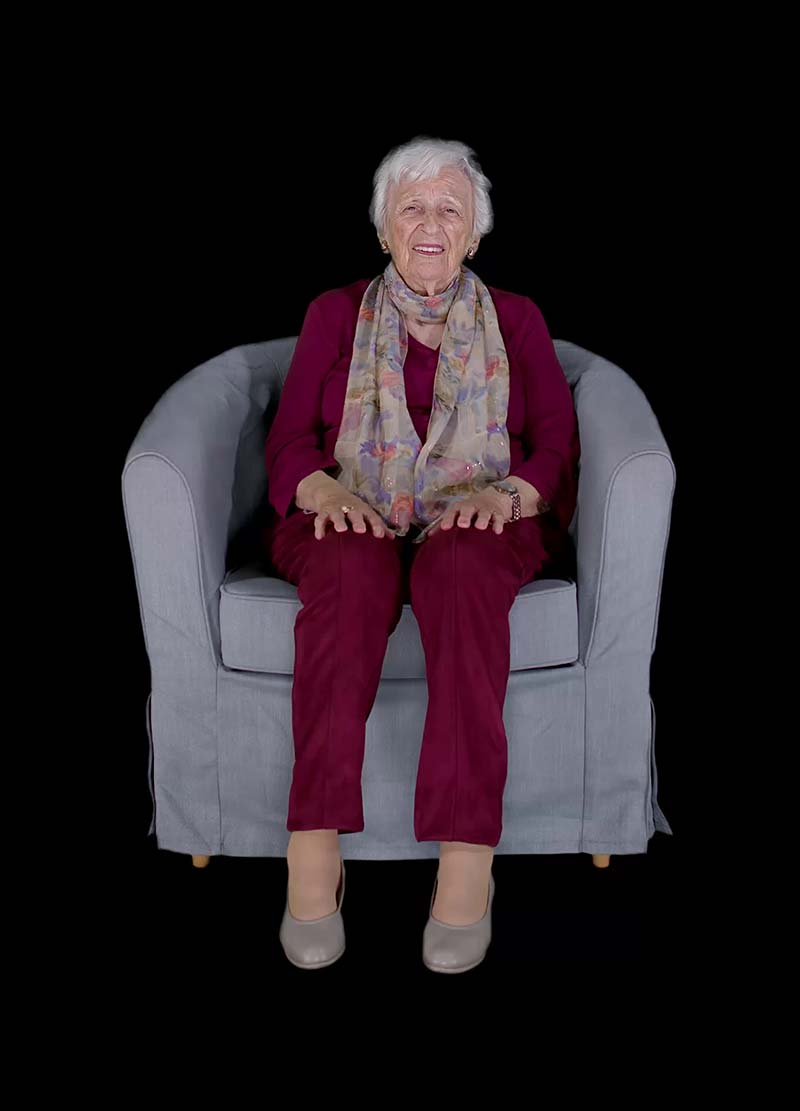
Peng Zhuying
Interviewed in Mandarin in 2020 in association with the Comfort Women Justice Coalition in Yueyang, China.
Peng Zhuyinh, or Grandma Peng, is a survivor of the “comfort women” system who lives in Yueyang City, Hunan Province, China. Grandma Peng was born in downtown Yueyang, in July of 1929, to a hearty family consisting of her parents, an older brother and sister, and two younger brothers. In 1938, the Japanese armed forces invaded and gas-bombed Grandma Peng’s hometown, causing the deaths of her mother and six-month-old brother. Age nine at the time, Grandma Peng suffered permanent vision loss from contact with the poisonous gas.
The Peng family fled to the suburban areas outside of the city. In 1939, Japanese soldiers abducted and forced Grandma Peng’s older sister to be a “comfort woman,” twice. In 1944, at 15 years old, Grandma Peng encountered the same ordeal: Japanese soldiers kidnapped, imprisoned, and violated her for a month. When the Japanese troops retreated from the area, she was able to return home.
As a “comfort woman,” Grandma Peng endured sexual violence, humiliation, and physical trauma, all of which resulted in lifelong health problems including the inability to have children. She got married in 1972, but still did not tell anyone about what she had suffered. Like many other “comfort women,” Grandma Peng kept her horrific experience to herself for fear of others looking down on her. Today, she is willing to educate the public by telling others of what happened to her.

Halina Zimm
Interviewed in English in 2022 in association with the Virginia Holocaust Museum in Richmond, Virginia.
Halina Zimm is a survivor of the Holocaust who lives in Richmond, Virginia. Halina was born on December 4th, 1927 in Lódz, Poland. She lived in Lódz with her parents, Solomon and Regina, and sisters, Helen and Nana. Following the Nazi invasion of Poland in 1939, Jewish people were forced to wear yellow stars and Jewish children were banned from attending school. Within a year of the invasion, Halina’s father evacuated the family to Zarnów, where Halina’s grandparents lived.
Around 1942, rumors that the Nazis planned to deport Jews in Zarnów began to circulate. Halina’s father obtained fake birth certificates for Halina and Helen, which allowed Halina to escape to Warsaw just two weeks before the deportations started. In Warsaw, Halina found a job as a housekeeper while concealing her Jewish identity.
Over the following years, Halina witnessed both the Warsaw Ghetto Uprising and the Warsaw Uprising. Halina lived close to the ghetto, and witnessed the fighting and destruction first-hand. In the summer of 1944, Halina participated in the Warsaw Uprising, a revolt led by Polish resistance forces. After the Nazi suppression of the uprising, Halina, along with many others, was deported by train to Germany to work as a forced laborer. However, Halina escaped and remained in Poland. Eventually she was liberated by the Soviet Army and met her future husband, Alan Zimm, in 1945. The two immigrated to the United States where Halina and Alan raised their family.
